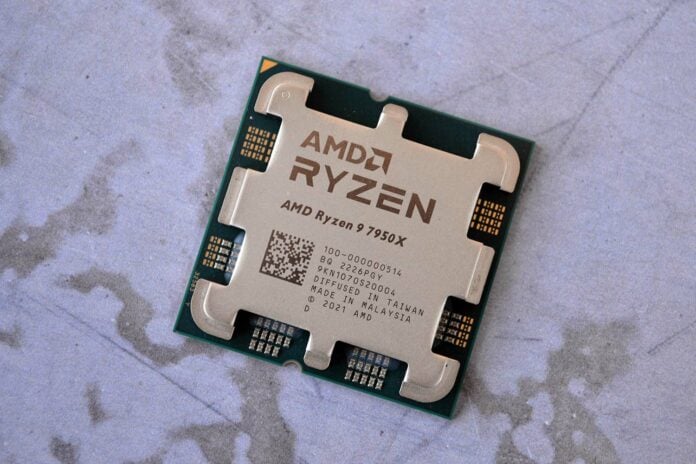Hello, Ryzen 7000 Series. You’ve kept us waiting a long time, but are you worth the wait? New is the name of the game as there are improvements to architecture, package, memory and platform. In one fell swoop AMD changes the landscape of mainstream PCs powered by Ryzen. Well, you gotta break with the past at some point.
Peeling back the latest Ryzen onion, let’s go from the highest level and then wind our way down to nerdy goodies like architecture changes. All aboard the Zen train. Choo-choo.
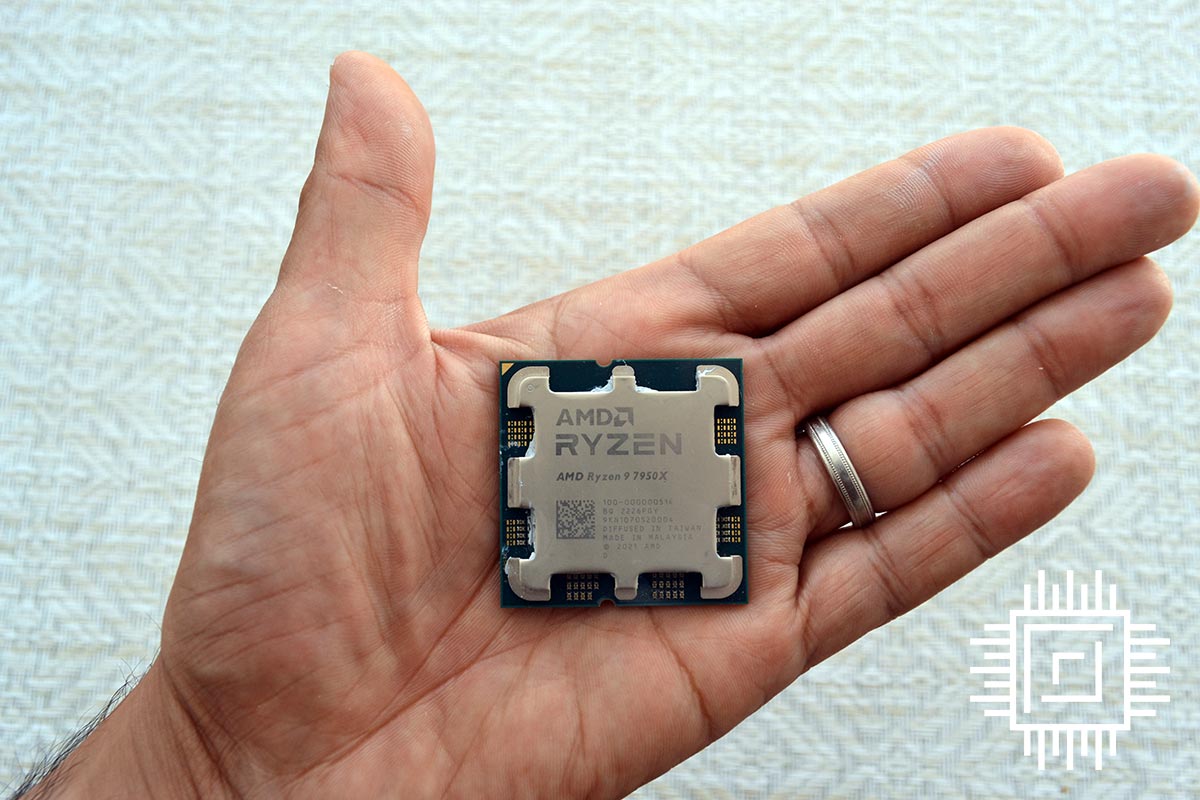

AMD Ryzen 9 7950X
£699 / $699
Pros
- Blistering performance
- Improved single-thread
- Great platform
- Good value
- Onboard IGP
Cons
- Power consumption
- Temperature
Club386 may earn an affiliate commission when you purchase products through links on our site.
How we test and review products.
Officially announced close on a month ago to whip up the appropriate levels of fervour and salivation amongst PC enthusiasts worldwide, AMD is not unleashing full-stack fury at rival Intel. Instead, there are only four Ryzen 7000 Series CPUs in the offing, and they target meaty budgets first. Makes sense to me because AMD wants healthy selling premiums on what is all-new technology.
The Need for Speed
| Model | Cores / Threads | TDP | L3 Cache | Base Clock | Boost Clock | Launch MSRP |
|---|---|---|---|---|---|---|
| Ryzen 9 7950X | 16 / 32 | 170W | 64MB | 4.7GHz | 5.7GHz | $699 |
| Ryzen 9 7900X | 12 / 24 | 170W | 64MB | 4.7GHz | 5.6GHz | $549 |
| Ryzen 7 7700X | 8 / 16 | 105W | 32MB | 4.5GHz | 5.4GHz | $399 |
| Ryzen 5 7600X | 6 / 12 | 105W | 32MB | 4.7GHz | 5.3GHz | $299 |
Where’s Ryzen 6000 Series, you may ask, and it’s a good question. AMD took away that naming opportunity by using the nomenclature for 2022’s mobile champions. And let’s face it, seven is bigger and better than six.
Four chips are mostly familiar to AMD aficionados as the core-and-thread count does not change between generations. In fact, headline 16C32T hasn’t moved since the Zen 2-powered Ryzen 9 3950X hoved into view in November 2019. A long time in the PC world, AMD has instead relied on the twin performance shovels of frequency and IPC to get the benchmark job done. Rival Intel, meanwhile, has been busy throwing as many asymmetrical performance and efficient cores into the latest generation. Divergent philosophies indeed.
| Model | Cores / Threads | TDP | L3 Cache | Base Clock | Boost Clock | Current price |
|---|---|---|---|---|---|---|
| Ryzen 9 5950X | 16 / 32 | 105W | 64MB | 3.4GHz | 4.9GHz | $550 |
| Ryzen 9 5900X | 12 / 24 | 105W | 64MB | 3.7GHz | 4.8GHz | $400 |
| Ryzen 7 5800X | 8 / 16 | 105W | 32MB | 3.8GHz | 4.7GHz | $257 |
| Ryzen 5 5600X | 6 / 12 | 65W | 32MB | 3.7GHz | 4.6GHz | $213 |
It’s certainly worth comparing high-level specifications against immediate predecessors. Two matters become readily apparent. The first is substantially larger power budgets for 12- and 16-core performance monsters. Second is much higher frequencies between comparable chips from each generation. Kind of goes hand in hand if you stop to think about it.
And in a nutshell, that’s the crux of Ryzen 7000 Series. A modicum of pure IPC gain is heavily augmented by a whole lot more frequency wick. The end result, according to AMD, is up to 40 per cent more multi-thread muscle, which is definitely not to be sniffed at.
All About The Core
Each evolution of a base architecture presents designers with an opportunity of doing things better. The beating heart of Ryzen 7000 Series is Zen 4, which is the brain that powers CPU cores. Like before, up to two core complexes – each carrying eight cores and 16 threads – hook up to a central input/out die (IOD). The devil is in the details when teasing out gen-on-gen improvements.
Outside of hard-nosed architecture refinements – steady your horses, technical readers – AMD doubles each core’s L2 cache from 512KB to 1MB, though closer-to-the-core L1 and more distant L3 remain at Ryzen 5000 series per-core levels of 64KB and 4MB, respectively.
But wait a second, doesn’t adding more cache balloon the transistor count and, potentially, die space? Yes, it does, but AMD’s magic trick is in adopting foundry partner TSMC’s 5nm high-performance process, down from 7nm used since 2019, and the net effect Zen 4 is able to shoehorn >50 per cent transistors yet take up less space. David Copperfield would be proud.
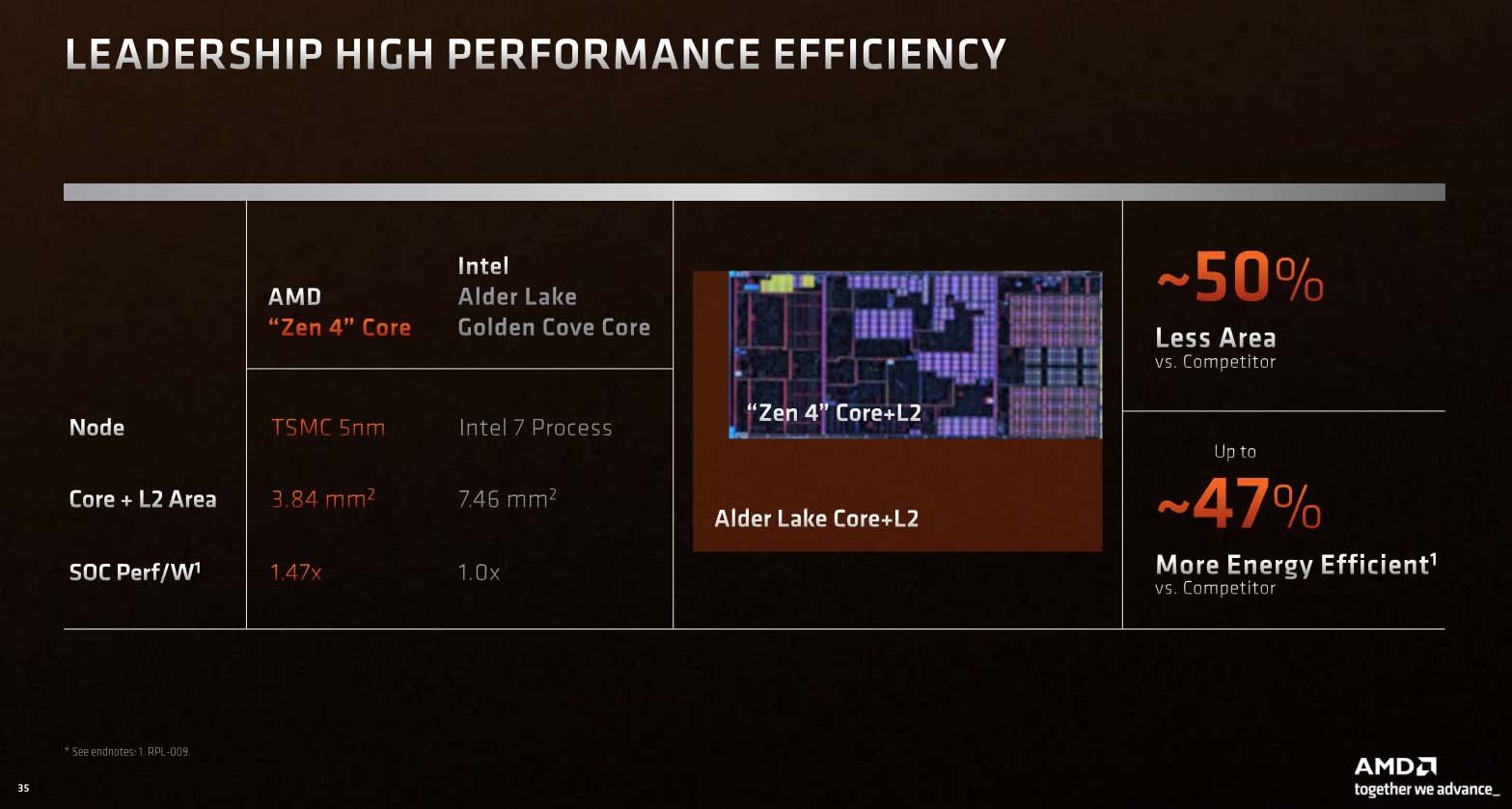
AMD takes an overt swipe at rival Intel by declaring each Zen 4 core and associated L2 is almost half the size of 12th Gen Golden Cove cores and their L2 cache. Hard to argue against that from a manufacturing viewpoint.
| Zen 4 | Zen 3 | |
|---|---|---|
| CPU fabrication process | 5nm | 7nm |
| CPU die size | 71mm² | 80.7mm² |
| CPU transistors | 6.50bn | 4.15bn |
| IOD fabrication process | 6nm | 12nm |
| IOD die size | 122mm² | 125mm² |
| IOD transistors | 3.40bn | 2.09bn |
New GPU-Laden IOD
AMD also invests a lot of extra silicon to the IOD die, which shrinks from 12nm to 6nm for the latest chips. Finding out where the extra 1.31bn transistors go is actually easy. As the IOD controls external interfaces to features such as memory and connectivity, there’s some extra die space apportioned there.
But that’s not the whole shebang. AMD grasps the die-size reduction opportunity with both hands and integrates graphics into the IOD. The question isn’t one of why, but one of why not, given the graphics heritage imbued in the company.
All Ryzen 7000 Series CPUs carry RDNA 2 graphics as standard. Don’t get too excited and think you can ditch that Radeon RX 6600 XT or GeForce RTX 3060. That’s not happening as the IGP is comprised of a two-CU, 128-shader cluster pulled over from mobile technology.
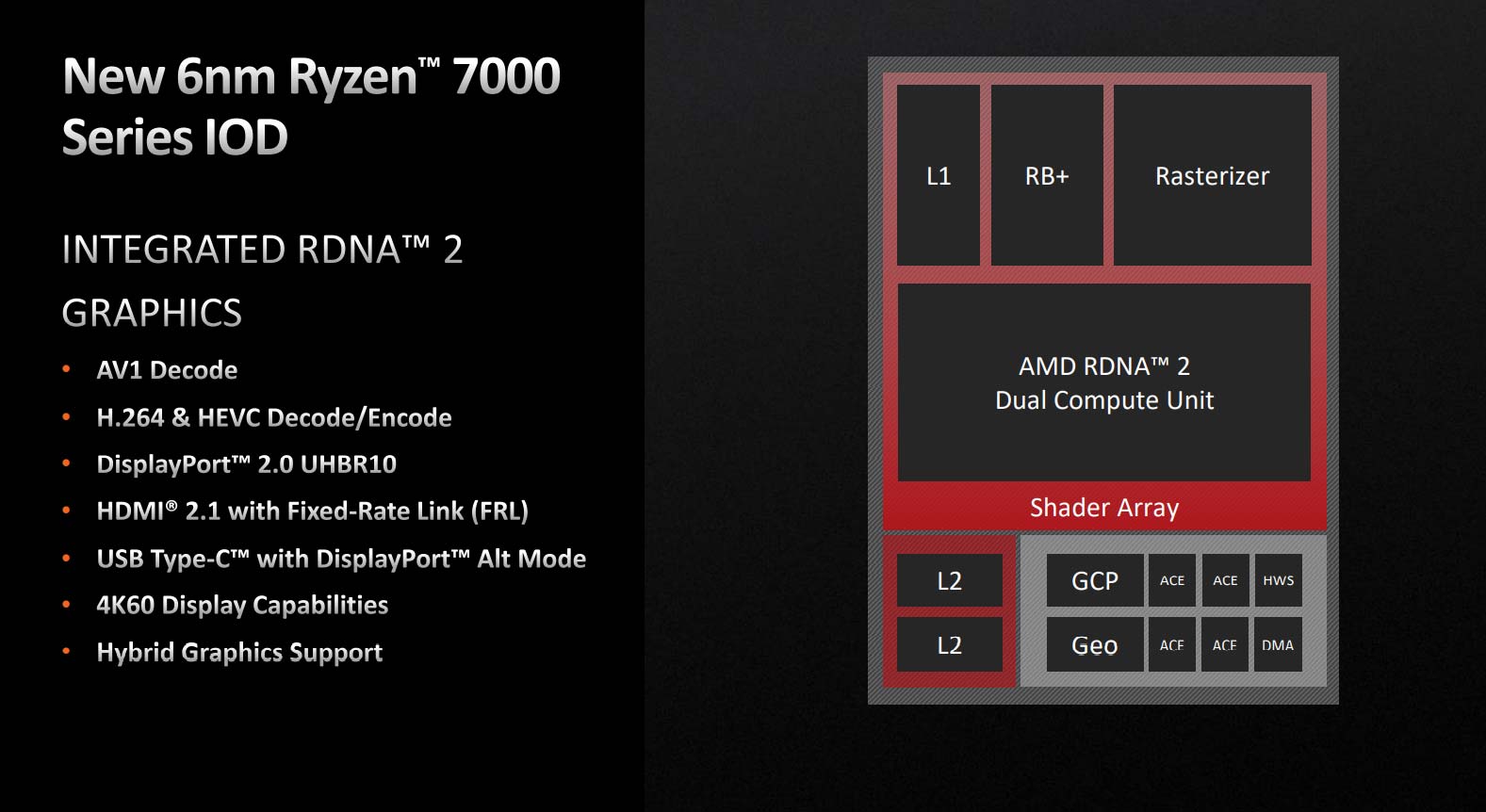
The main purpose of these graphics is to enable all Ryzen 7000 Series CPUs to fit into systems that don’t require heavy GPU capability. Truth be told, that’s millions upon millions of PCs, and AMD has historically required add-in discrete cards for most 5000 Series chips or resorted to a few G Series. Intel, on the other hand, has been mining this rich volume seam for years with low-power, flexible-output IGPs baked into each generation of Core. AMD wants a slice or two of that pie.
The two-CU GPU arrangement is eerily similar to the built-in graphics on just-announced Ryzen 7020 Series processors. Expect a pinch of gaming performance for light-load eSports titles played at, say, 720p with basic settings, yet display flexibility is arguably as important. The GPU features a strong roster of encode/decode abilities and display outputs – certainly enough not to need a discrete card in a small-form-factor PC. AMD has severed the necessary link between most Ryzen processors and discrete cards, and that’s a good thing.
What’s Going On, Zen 4
Resident CPU guru and known as ‘father of Zen’ in close-knit circles, Mike Clark headlined the recent Architecture Day by positing Zen 4 enjoys a geomean average 13 per cent instructions-per-cycle (IPC) uplift over in-market Zen 3, judged at the same frequency.
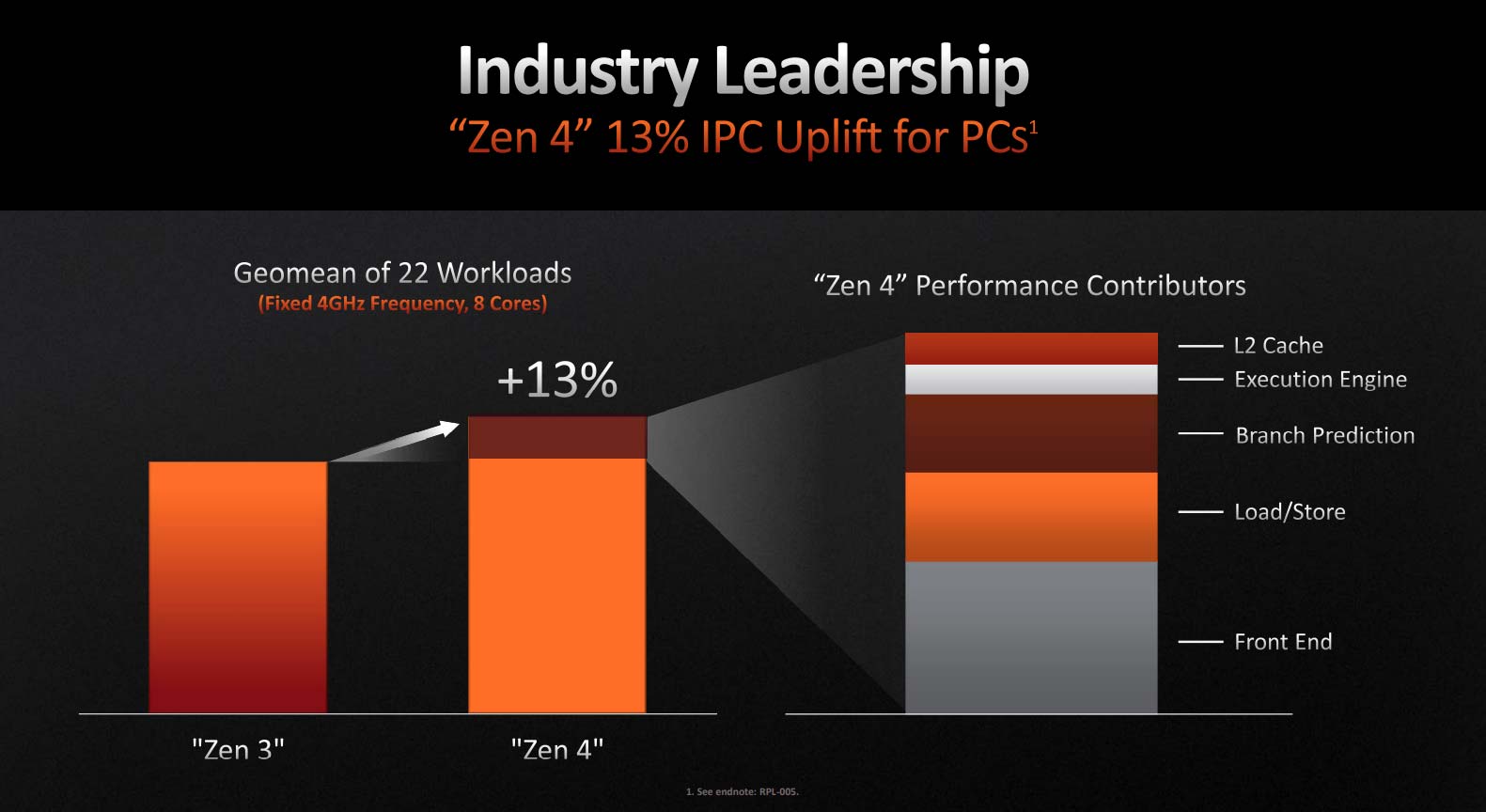
As frequency and not IPC is the main driver of Ryzen 7000 Series’ performance progression over the previous generation, we’re okay with the apples-to-apples uplift. It’s actually surprising how little extra performance is provided by the doubling of per-core L2 cache, bringing into question where it was necessary for this round of chips. Most of the gains – around 80 per cent or so – emanate from three areas: the front-end, load/store, and branch prediction.
This is telling insofar as most of the architectural tweaks derive from optimisations to what’s referred to as ‘feeding the beast.’
Front-end and branch prediction advances afford the largest portion of IPC gain – somewhere in the region of 60 per cent – and the key here is the increase in the size and processing ability of operation cache. The reasoning is simple enough because Zen 4, like its predecessor, keeps to a decode rate of four regular instructions per cycle, which is weak when the queue can dispatch six into the execution engines.
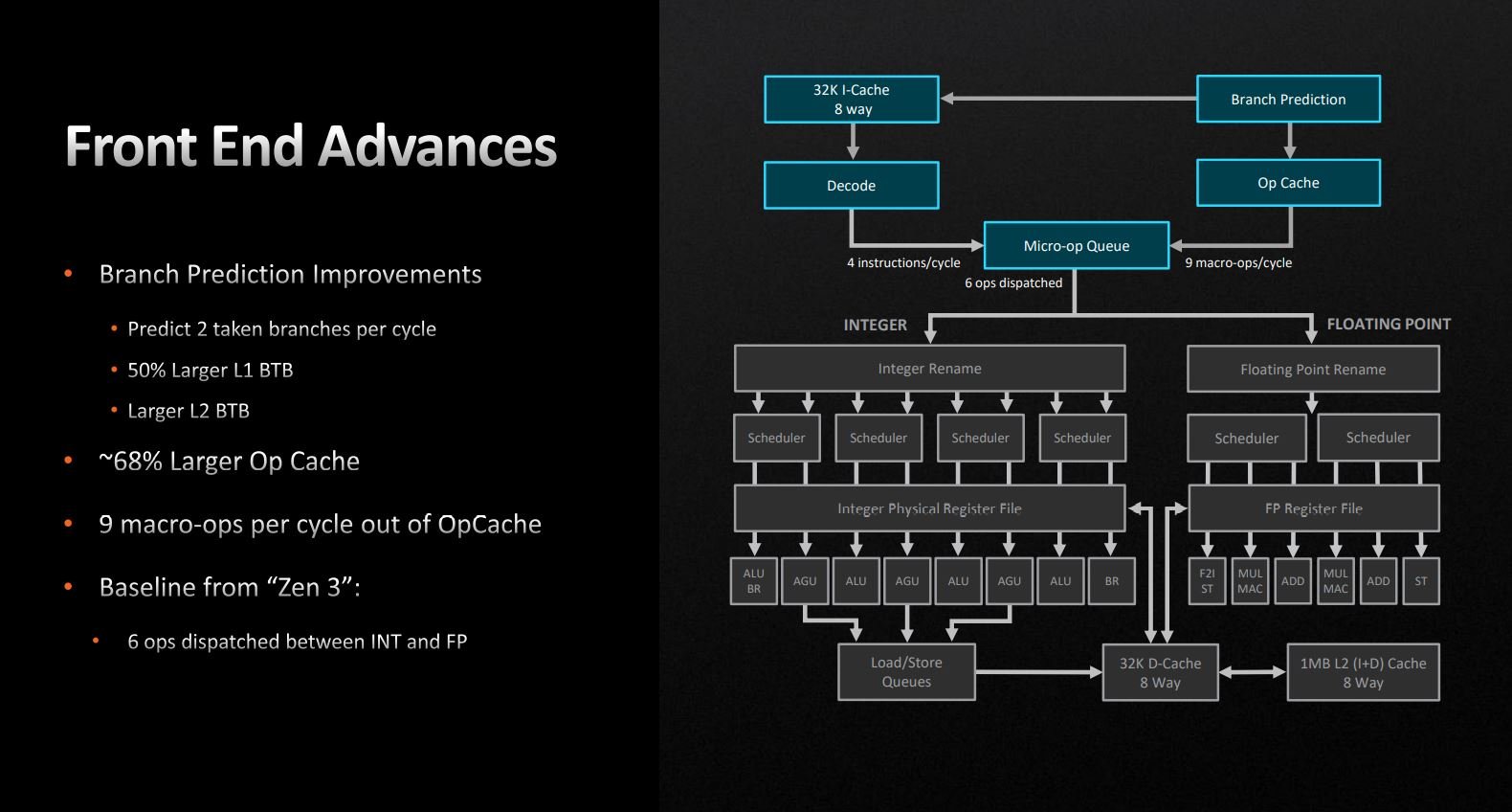
AMD got around this by having a 4K L0 op-cache on Zen 3, but this is increased to around 7K on Zen 4, alongside larger supporting buffers. And that’s been a hallmark of Zen evolution over the years. Zen 2, for example, had an L1 Branch Target Buffer (BTB) of only 512 entries; Zen 3 increased that to 1,024, and Zen 4 goes up to 1,536 entries. It wouldn’t surprise us one iota if Zen 5 doubles buffer and cache sizes again.
The easiest way to visualise the overall benefit is to imagine the front-end being a funnel into the core’s engine – the wider and more efficient it is, the better one can saturate the execution engines. Some of the most sought-after CPU architects are high-quality front-end merchants… and with good reason.
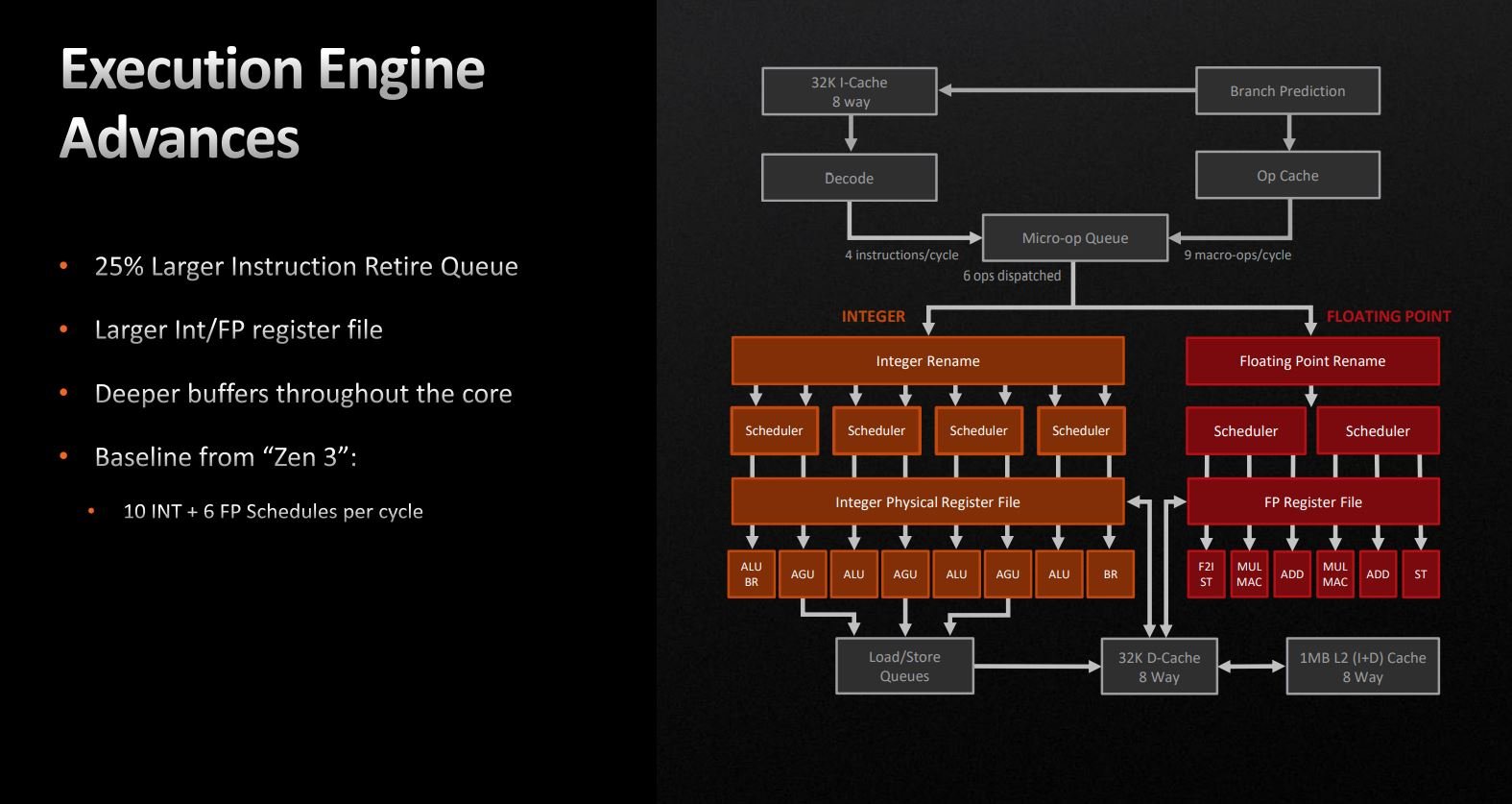
If you’re going to feed the beast more, it better have the stomach to digest bigger portions. This is where larger instruction retire queues and register files come into play. Adding them takes transistor space, explaining why Zen 4 is fundamentally larger than Zen 3, though it’s considered worth the expense as performance benefits outweigh the cost of implementation.
Moving on down to load/store units, Zen 4 goes, you guessed it, larger in areas that matter. Of particular note is the 50 per cent increase in L2 DTLB, though from what we can glean, it may be less associative.
This birds-eye view of key changes reinforces the message doled out above. AMD spends most of Zen 4’s additional resource into expanding buffers, caches and queues. The downside of doing so is increased latency out to larger, slower L2 and L3 caches, yet a few cycles can be masked by more in-flight processing.
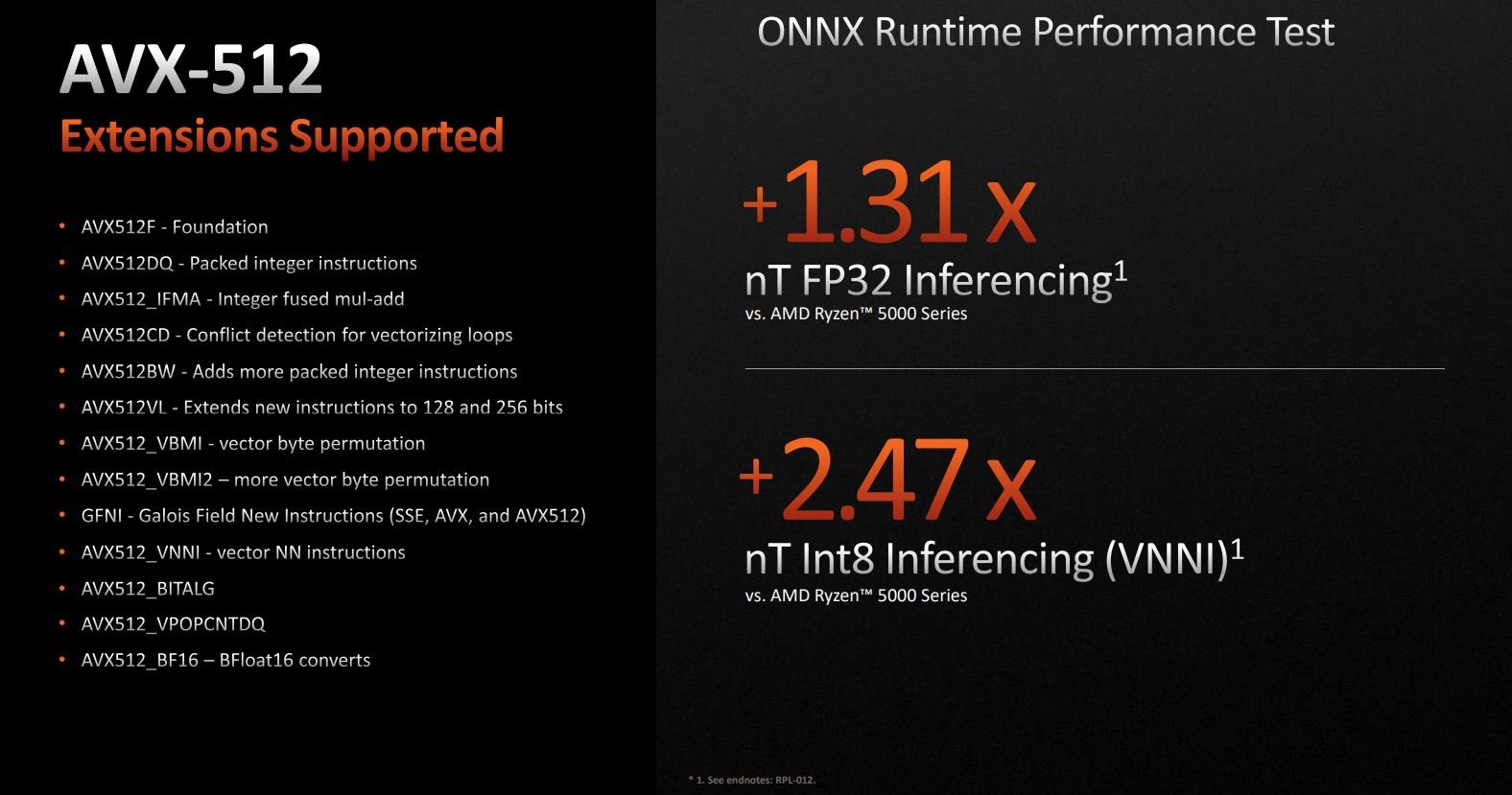
Did we forget to mention AVX-512 support? How remiss. Zen 4 does indeed support most of the feature-set but does so in an interesting way. Rather than go for a single, 512-wide ALU, which is the optimal but expensive way, AMD chooses to double-pump 256-bit-wide instructions. This approach is slower than a native implementation, of course, and Zen 4 does it this way, we imagine, in order not to hurt frequency too much. Full-on AVX-512 workloads have a habit of dragging speeds down and thermals up.
Going double-pump, though not ideal, is a good middle ground for consumer processors and fits neatly between regular AVX-256 and proper AVX-512 performance. Showing how noisome AVX-512 can be, Intel officially doesn’t support it on recent 12th Gen Alder Lake processors, which naturally puts AMD at an advantage in specific media workloads. Being fair, there’s little in the way of AVX-512-optimised software at the moment, yet AMD jumps on the mantra of if you build it, they will come.
Fight For Frequency
Design decisions within Zen 4 all tell one story. Architecture refinements play second fiddle to the quest for much higher frequency than available on Zen 3. According to all-round AMD genius Joe Macri, a multi-year collaboration with foundry partner TSMC, which has become closer over time, has enabled the duo to fine-tune high-performance 5nm silicon for elevated clocks.
The exact nature of the silicon remains unknown, but we do know AMD actually failed in the original aim of releasing Zen 4 with a top-bin speed of 6GHz. As 5nm matures, AMD may take very select dies and launch a wattage-unencumbered ‘Ryzen 9 7990X’ with that seminal frequency. But hey, 5.7GHz ain’t bad right out of the gate. Rival Intel appears to have beaten AMD to the 6GHz punch by sort of announcing the upcoming Core i9-13900KS.
Stratospheric single-thread speeds are all well and fine. We’re more impressed by the multi-core prowess of Ryzen 9 7950X, which hovers on the right side of 5GHz when everything is run at 11. Oops, letting the proverbial cat out of the benchmark bag there.
Packaging Opportunities – AM5
AMD’s mainstream chips since 2017 have been resident on the AM4 platform. Fantastic socket longevity provides ample upgrading opportunities over time, considered one of AMD’s key strengths – Ryzen 9 5950X, for example, can be run on select X370 motherboards from way back when – but is an obstacle when designing feature-rich, powerful platforms for the next five years. Something has to give, and in this case, AM4 is the sacrificial lamb.
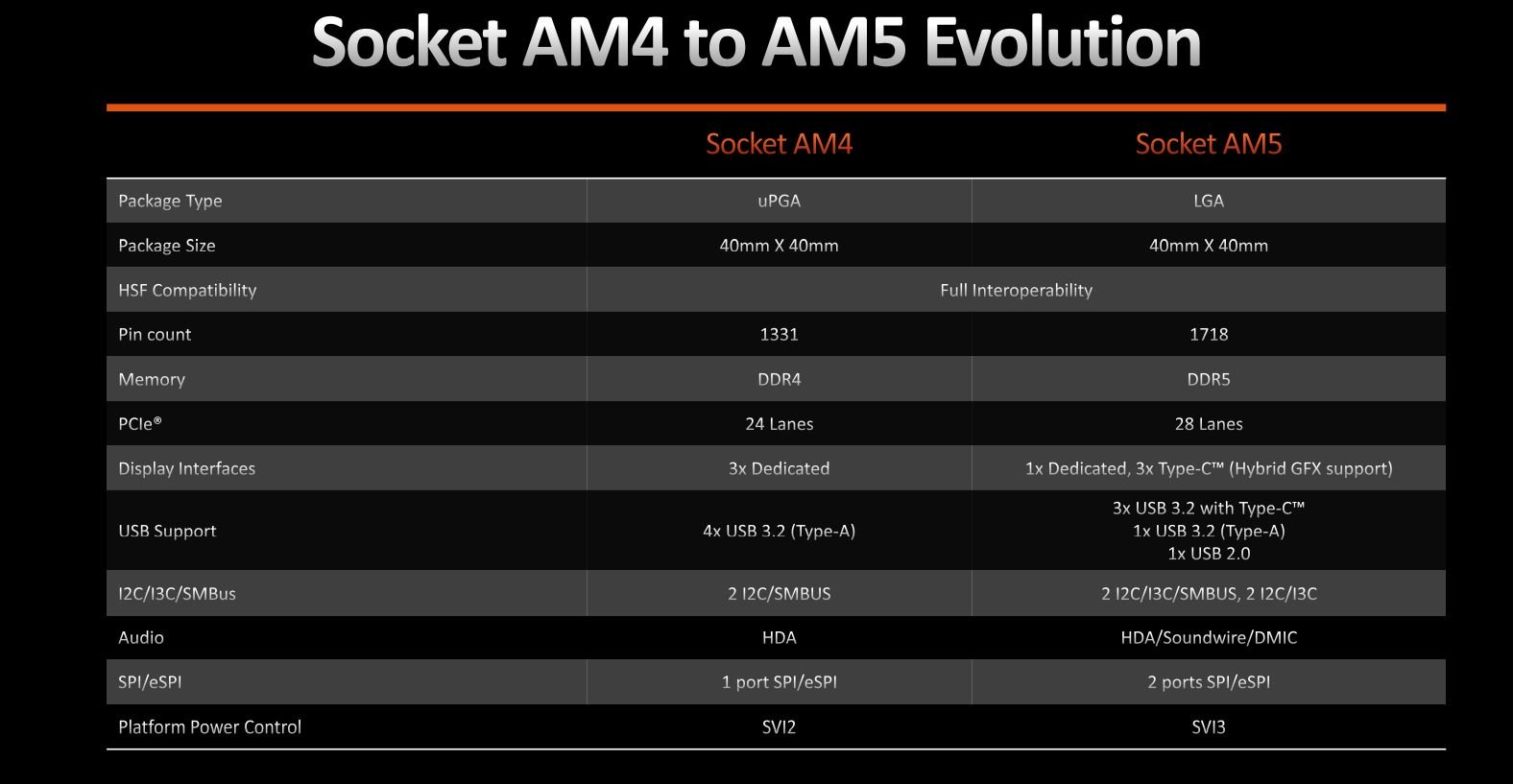
Which all leads me on to the second point about Ryzen 7000 Series. The chips use the AM5 form factor that’s just not compatible with gnarly, old AM4. You see, AMD transitions to an LGA1718 socket from PGA1334, meaning the pins are located on the motherboard, not the CPU, as is the case with AM4.
AM4, it has to be said, is the outlier in AMD’s processor stable. High-performance Threadripper (Pro) and server-optimised Epyc have been on an LGA footing since time immemorial; AM5 joins them. No more bent pins on the CPU, though watch out for dropping anything in the socket! In a concession to legion enthusiasts, AMD doesn’t change the 40mm x 40mm socket area, meaning you can re-use AM4 cooling. Another plus point is motherboard makers don’t have to completely redesign boards. A win-win.
Back on point, it’s the extra 29 per cent of pinnage that largely enables AMD to feed high-end beasts with more power. Sure, AM4 could scale high with lots of voltage, but it wasn’t designed to run close to 200W – AM5, on the other hand, laps it up. Extra routing pins also offer plenty of scope to add more features and performance in the future. With all that in mind, I believe shifting the entire mainstream ecosystem is the right idea, even if it doles out short-term pain by closing long-in-the-tooth upgrade paths.
DDR5 – The Only Show In Town
Five appears to be the magic number. AMD makes the move to DDR5 memory almost a year after Intel brought it to the mainstream with 12th Gen Core. Unlike its rival, Ryzen doesn’t bother with also carrying DDR4 compatibility. Want Ryzen 7000 Series, you better budget for DDR5 memory.
The good news is DDR5 memory is becoming more affordable each passing month. A high-performance 32GB kit is available for around £200, which is about 50 per cent more than the cost of enthusiast-grade DDR4. £70 premium for memory is small beer when considered in the wider sense, so whilst DDR4 support would have been nice, especially for budget builds featuring lower-end Ryzen 7000 chips, it ain’t a deal breaker.
One man’s dual-channel DDR5 implementation isn’t the same as another’s. AMD’s distils down as follows:
| Configuration | Maximum speed |
|---|---|
| 1x single-rank | 5,200MT/s |
| 1x dual-rank | 5,200MT/s |
| 2x single-rank | 3,600MT/s |
| 2x dual-rank | 3,600MT/s |
The takeaway is simple. Sticking four modules into a motherboard results in officially supported speed dropping from a nice 5200MT/s to just 3,600MT/s. Sure, most enthusiast boards will offer much higher speeds, and run stably at that, yet the steep frequency drop-off isn’t ideal. Put simply, run with two modules if you can. Now where are those 64GB modules running at 6600MT/s?
Getting granular on a platform level, you may remember Ryzen 5000 Series CPUs tied the internal memory clock speed to Infinity Fabric speed and integrated memory controller. This changes on Ryzen 7000 Series because of the higher speeds offered by DDR5. In practise, internal RAM speed is still run on a 1:1 ratio with the IMC but the Fabric clock drops down to a 3:2 ratio.
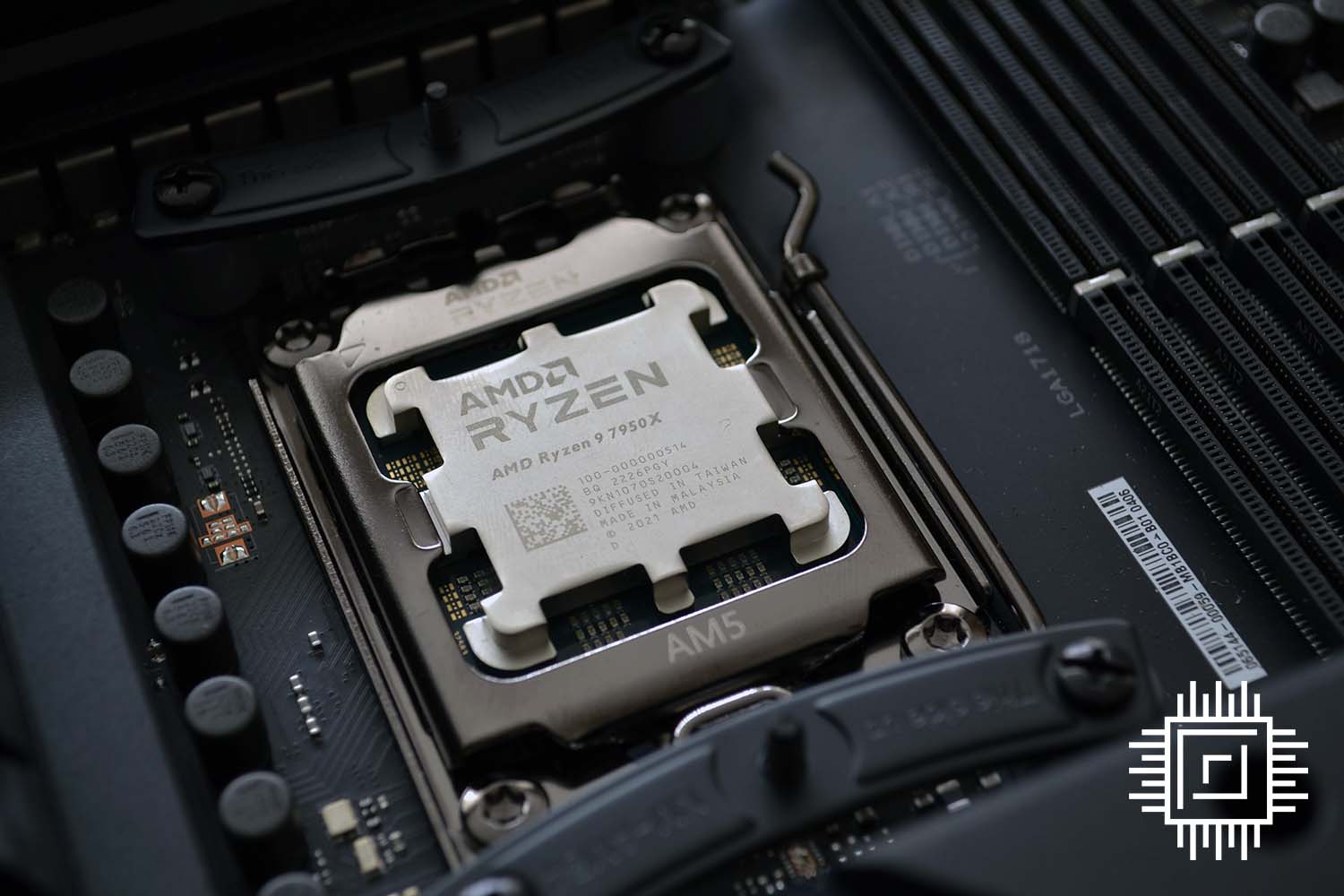
Let’s take an example of DDR5-5200 memory. It actually runs at 2,600MHz internally, which ties to the frequency of the IMC (also 2,600MHz). Infinity Fabric, meanwhile, runs at 1,733MHz on a 3:2 ratio. Put simply, getting the IF clock to 2,600MHz is not going to happen.
You may have read about a sweet spot memory speed of DDR5-6000, and there’s good reason why that works well. The IMC also scales to 3,000MHz in that instance while IF chugs along at 2,000MHz. All good. Running past an internal 3,000MHz DDR5 clocking causes the IMC to halve in speed, while IF fidgets between 1,850-2,100MHz.
The key to fast running is symmetry. You may find application performance is marginally slower with DDR5-6400 as the IMC speed is cut to only 1,600MHz.
Chipset Bonanza
Motherboard makers lick their chops when a new socket comes out. Catering for the enthusiast first, AMD’s partners are now releasing X670E and X670 chipsets. Boards are expected to cost from £200 and scale up to, well, more paper than most wallets hold.
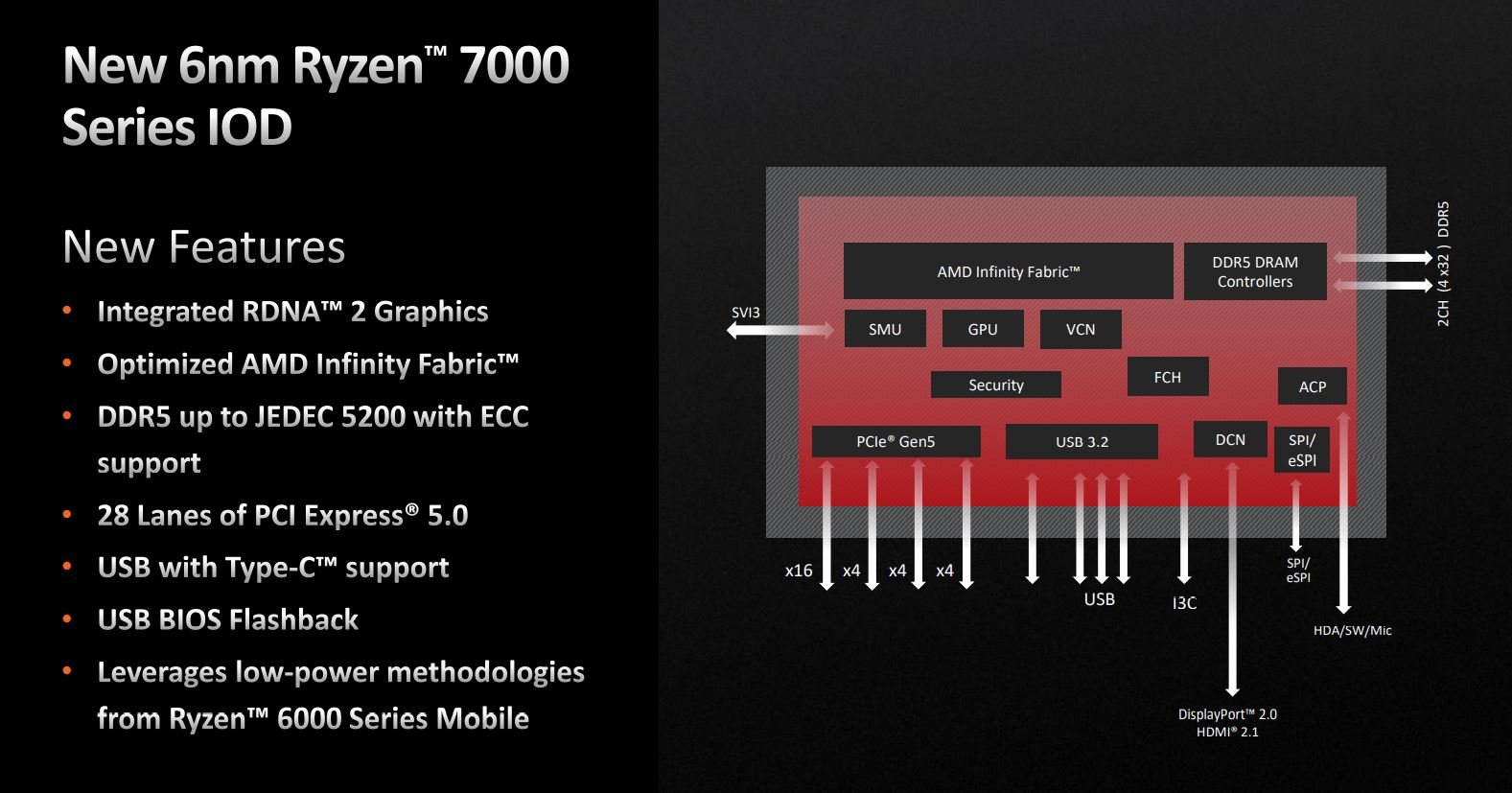
A lot of the expansion goodies are held on the IOD section of the CPU, and you will receive this connectivity mana, illustrated above, irrespective of chipset employed. Compared to Ryzen 5000 Series processors, which are still considered rich in features, AMD increases PCIe lanes from 24 to 28. That’s only half the story as Ryzen 7000 Series upgrades them to speed-loving PCIe 5.0.
This actually shakes out simply. You now have one more CPU-integrated PCIe x4 link ostensibly for additional storage, run at up to PCIe 5.0 for upcoming SSDs. In a nod toward legacy support and BIOS flashback updates, AMD further adds a single general-purpose USB 2 port.
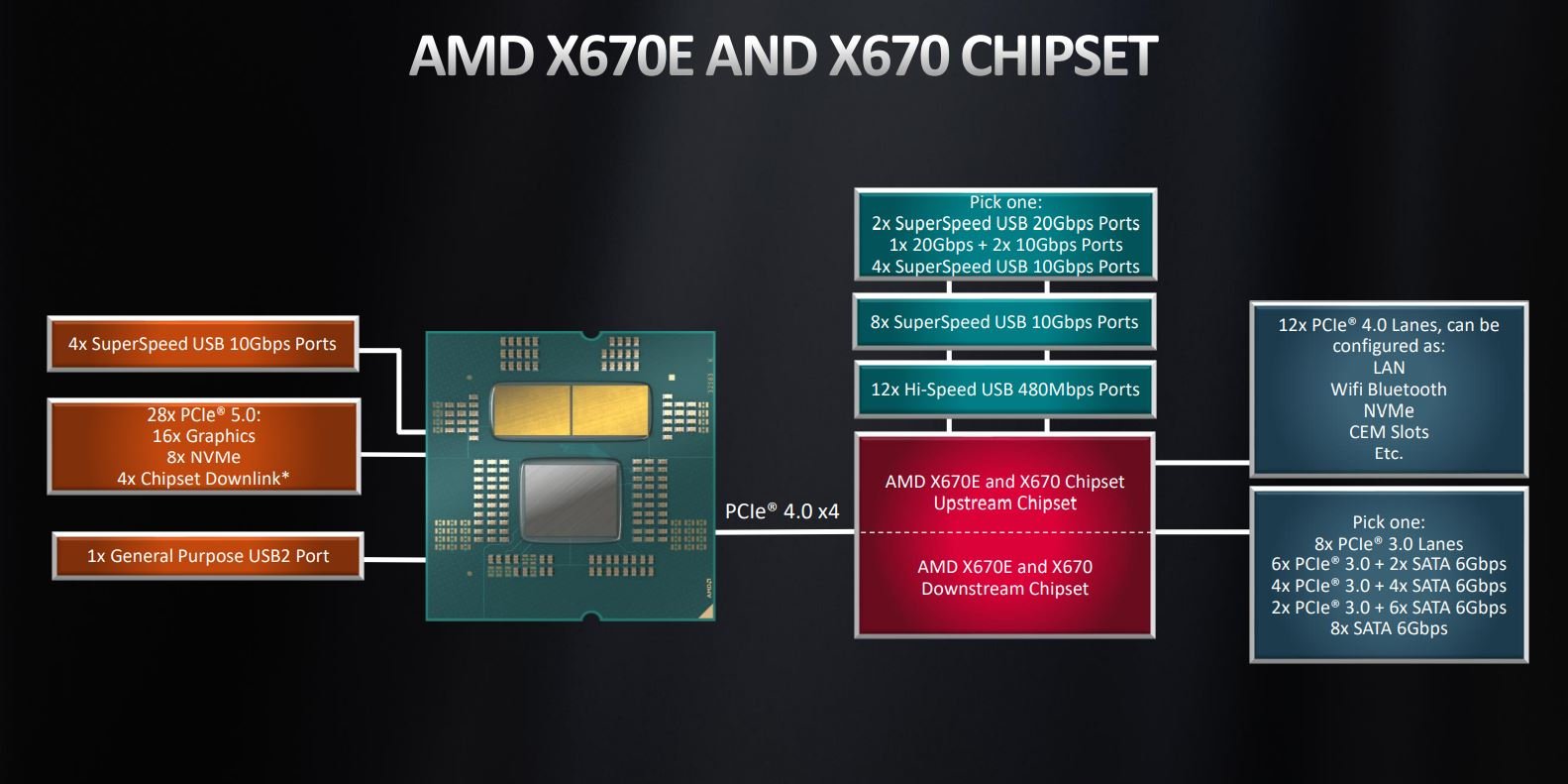
Four of the aforementioned 28 lanes emanating from the IOD portion of the chip are purposed into PCIe 4.0 for connecting the CPU to the chipset. And it is a set of chips this time around. Look closely to determine X670E and X670 utilise a two-chip solution. Known internally as Promontory 21 and built by ASMedia, both are not connected directly to the CPU. Rather, only the first is via the shown PCIe 4.0 x4 link. The second daisy-chains to the first via another PCIe 4.0 x4 internal link and has to run through it to pass data to the processor. A downside is potentially higher access latency on the second Prom 21, but an obvious benefit of a two-chip solution is that one can double-up on connectivity without needing a single, super-large solution. Once you understand this, the decent connectivity increase in supported devices compared to X570 makes implicit sense.
New X-series is therefore able to go real heavy on USB. Remember X570 natively supported up to 12 ports – eight USB 3.2 G2, four USB 2.0 – X670/E’s two-chip solution offers up to 20 of various speeds, with the option, for the first time, to have a couple of 20Gbps rolled into the mix. Nice.
Looking across, general-purpose lanes increase from eight to 12, and AMD throws in heaps of PCIe 3.0, as well. If you’ve got the chip features and bandwidth, why ever not. Both run at around 7W full chat, which when spaced out on a motherboard is okay for operating without the fans we saw on all original X570 boards. Good news.
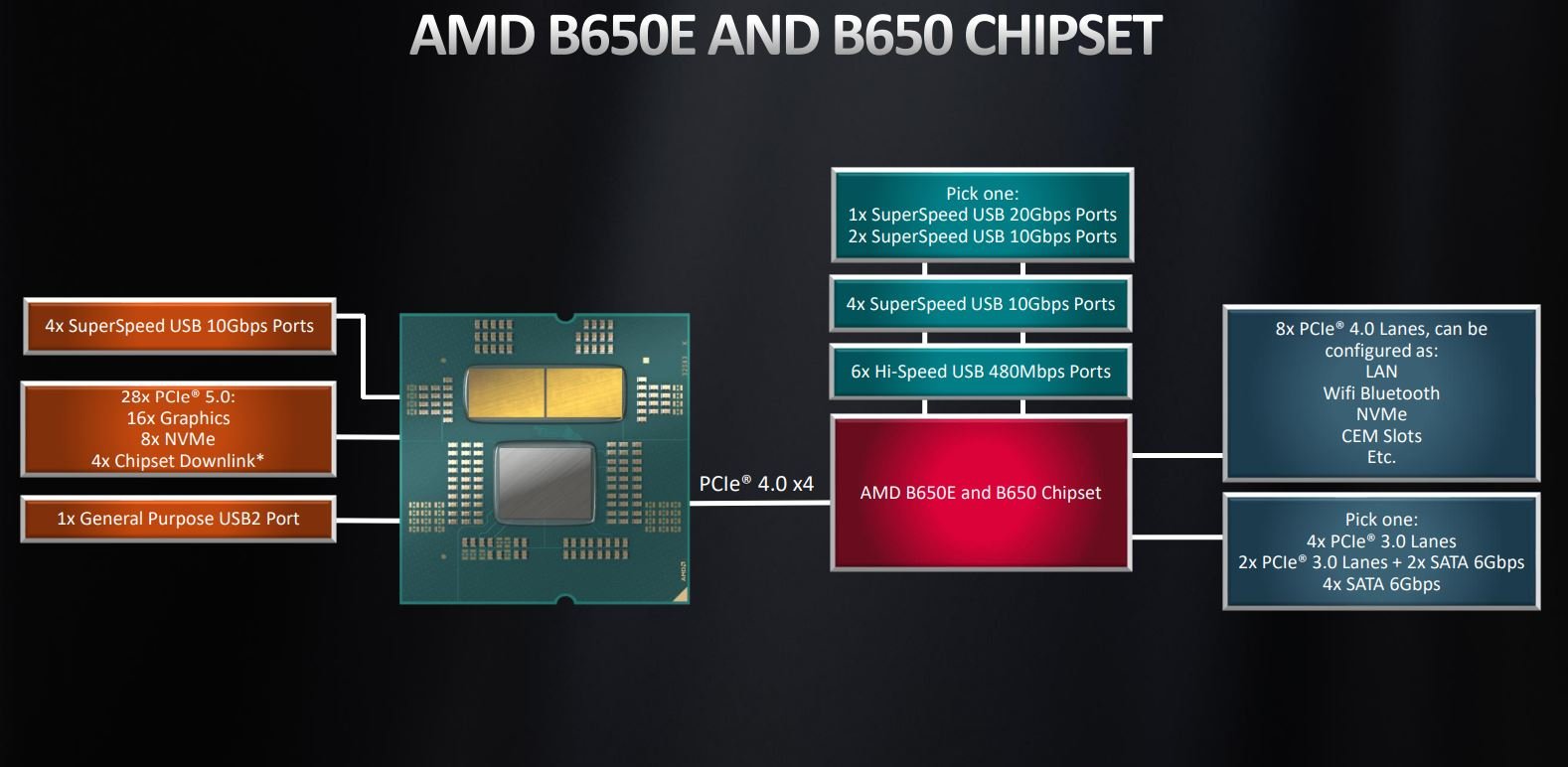
Motherboard manufacturers won’t need to add many discrete chips for a fully-fledged board, and it’s only USB 4 that’s conspicuous by its absence. Even that’s not quite the headache that it could have been; most motherboard guys with premium offerings will use either the ASMedia ASM4242 or Intel Maple Ridge two-port USB 4 host controllers running off spare CPU PCIe lanes.
The CPU
Well done for getting down this far, and boohoo for any reader who navigated here using the jumpbar at the top.
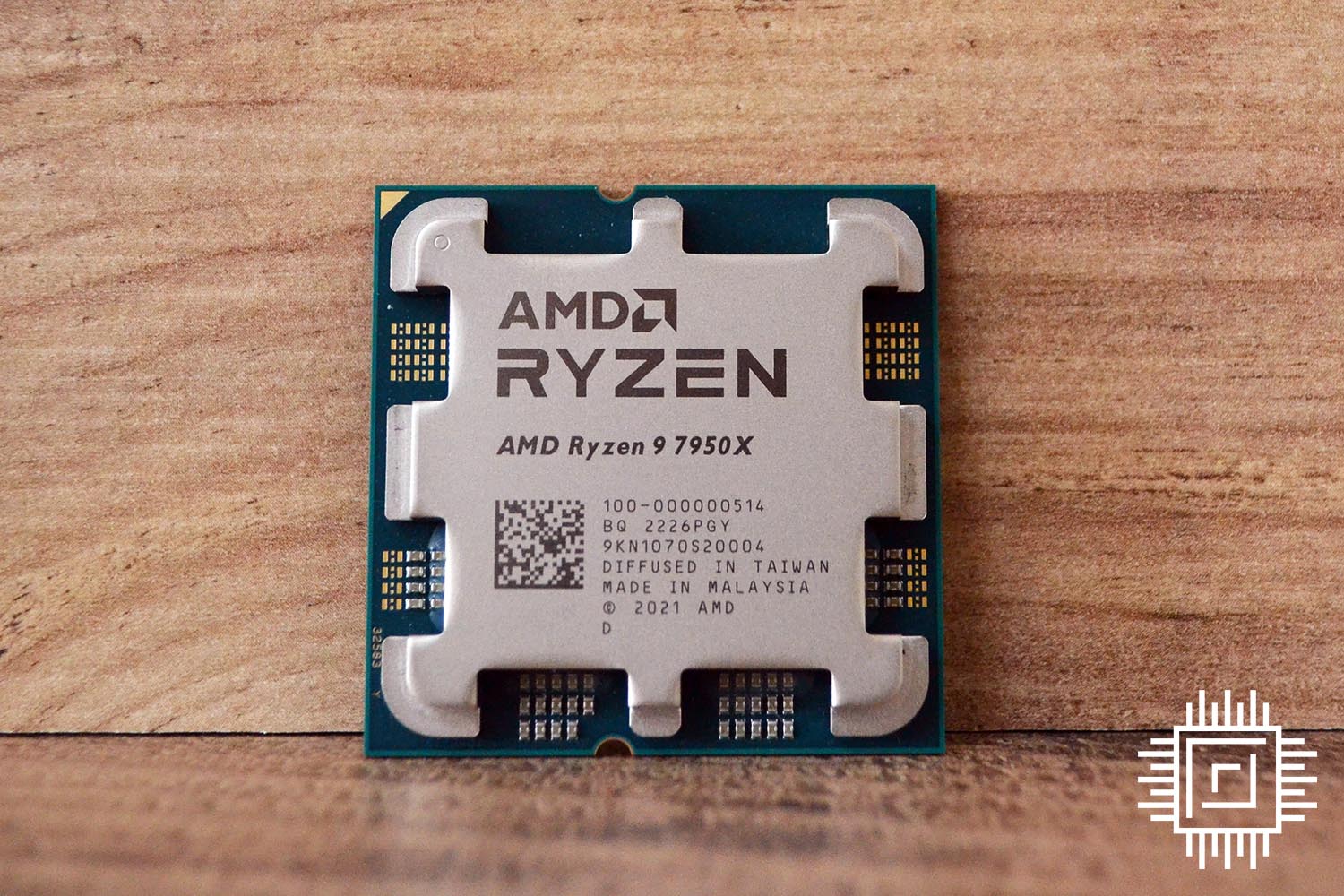
Thar she blows. Looks a lot different to a Ryzen 5000 Series chip, don’t you think. And there’s good reason for that. You see six SMDs grouped alongside the edges of the substrate. They are a collection of capacitors and resistors that govern the electrical conduit between pins and silicon. AM4, on the other hand, hides its SMDs within the confines of the heatspreader. There is no room to do so this time around, so that’s why AMD chooses what we call the octopus design.
One downside of this approach, where SMDs are deliberately visible on the upper side, is possible short-circuit faults arising from using conductive heatspreader material between chip and cooler. We’re looking at you, liquid metal. And what a pain it will be to clean off regular thermal interface material when changing processors – those pesky cutouts are perfect hiding places for tiny amounts of paste.
It wouldn’t surprise us in the slightest if enterprising cooling companies released IHS-height shims that covered SMDs and gave the entire socket a cleaner look.
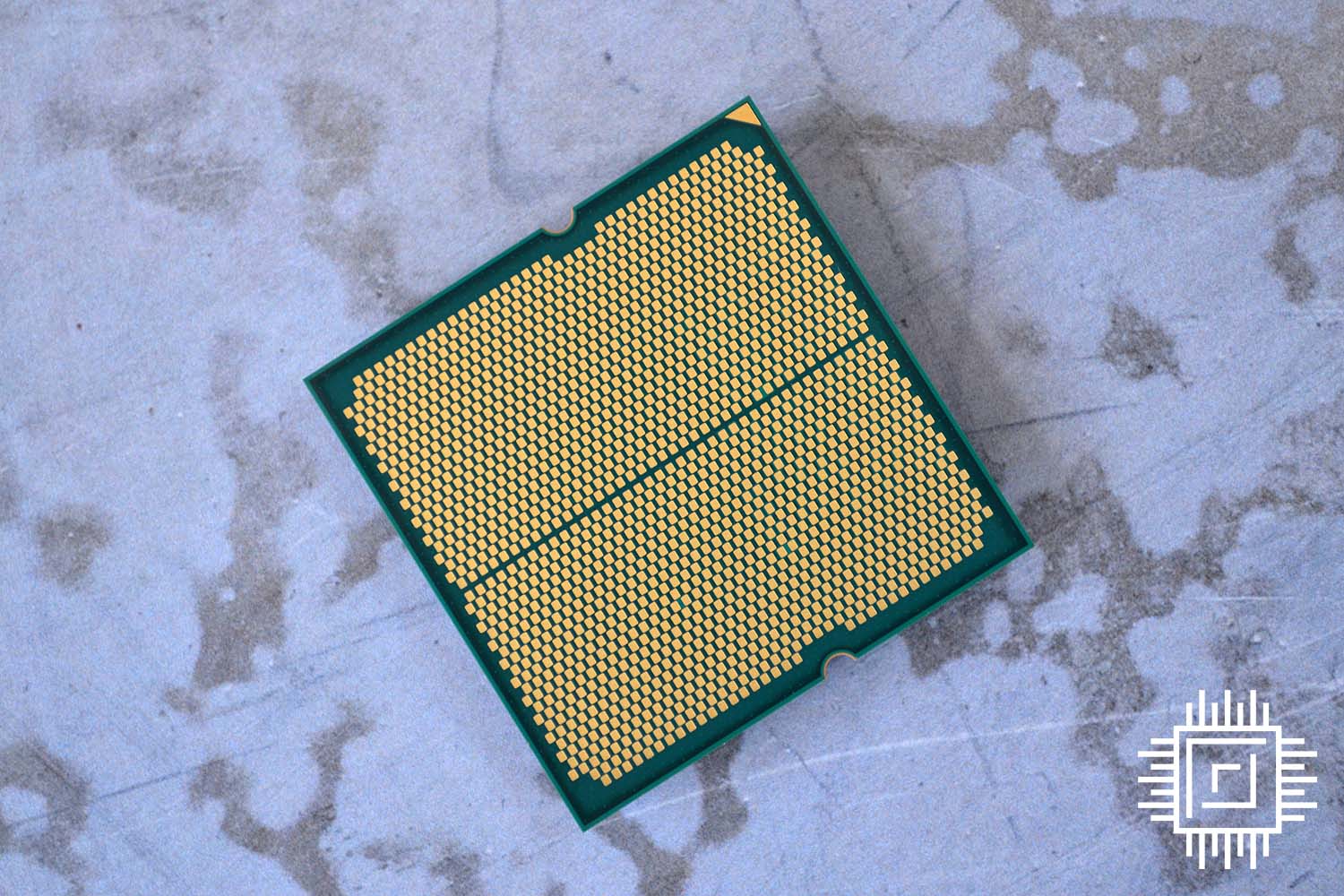
Ever seen a regular Ryzen without pins on the back. Not until now. Ryzen 7000 Series brings much-needed continuity to the processor line-up and means you don’t have to be extra-careful in handling a chip from this generation.
The weight is distributed more on the top of new Ryzens, though at 38g, they’re actually a gram lighter than, say, a Ryzen 5000 Series CPU. Pads weigh less than pins, stating the obvious. Nevertheless, I’m a fan of the new design from both visual and installation perspectives.
Enthusiasts who changed AM4 processors often knew they had a tendency to rip out of the socket when the heatsink was removed – the TIM bond strong enough to disengage pins from board. Having to prise off the chip from the bottom of a large cooler is certainly no fun. That issue is fully mitigated with Ryzen 7000 Series, as I couldn’t, after repeated attempts, coax a Noctua NH-D15 chromax.black into pulling the 7950X away. Makes sense when you consider part of the holding mechanism remains planted on top of the AM5 processor. Hurrah.
AMD refrains from adding a cooler into any Ryzen 7000 Series box, with the intention being one of enthusiasts will already have decent cooling in place. No bother for a truly high-end chip like this, but part of me says a cooler ought to be in the Ryzen 5 7600X box. Care to disagree? Flame me.
Performance
Admit it, this is the section you’ve really been waiting for. There’s been much bombast in AMD’s claims of a true generational performance uplift without having to implement more cores and threads. Frequency and, to a lesser extent, IPC are the twin hammers AMD leads with.
We dread to think of the energy bill at Club386 HQ this past week; our test platforms have been benchmarking in overdrive! Ryzen-coloured smoke has been seen rising from the labs, where 7000 Series chips were evaluated on an Asus ROG X670E Hero motherboard outfitted with 32GB (2x16GB) of G.Skill Trident Z5 Neo EXPO memory operating at AMD’s official specification, 5,200MT/s, plus Nvidia GeForce RTX 3080 graphics and Noctua NH-D15 cooling.
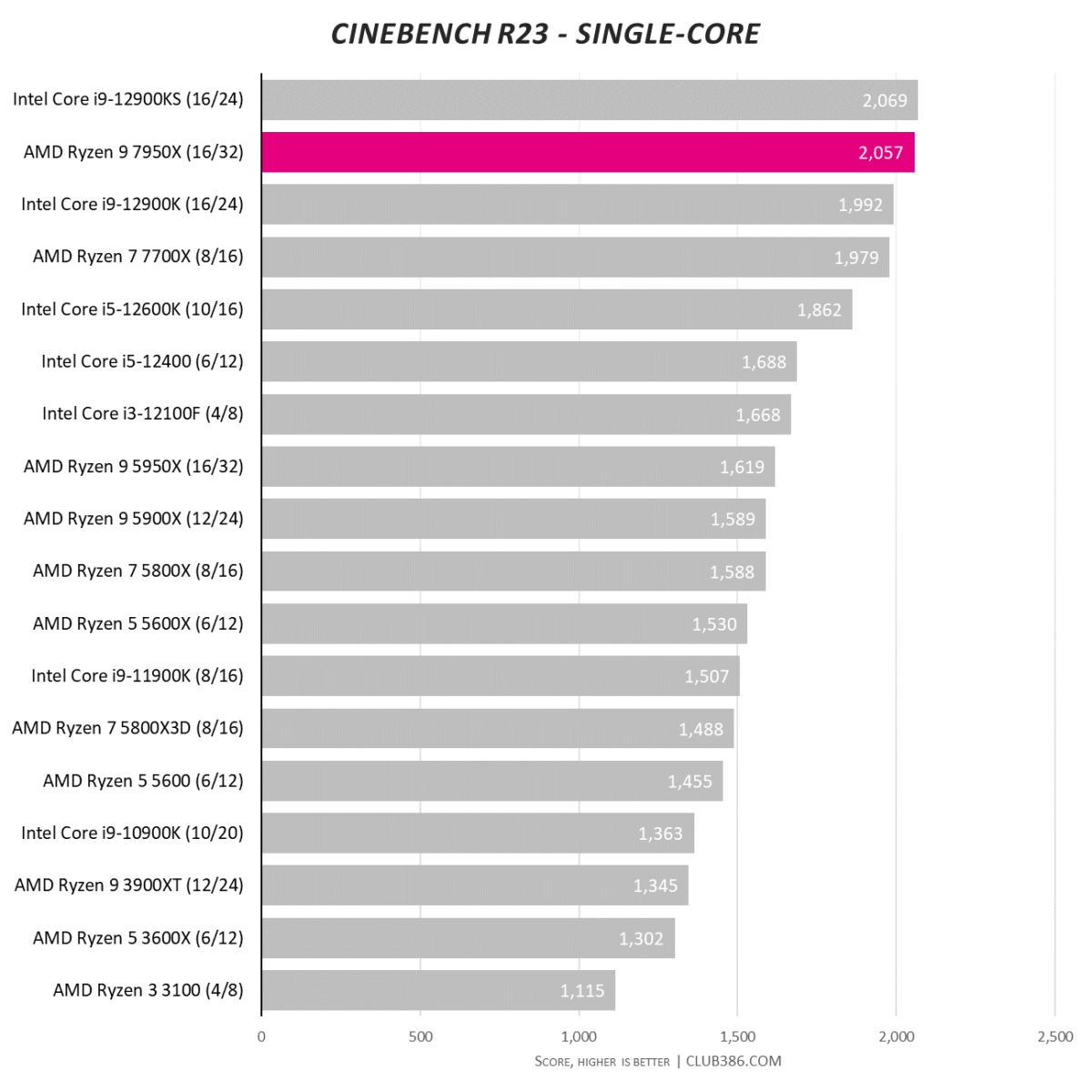
Cranking up the light-load frequency is a sure-fire way to jump up the charts. Ryzen 9 7950X does indeed ramp to 5.7GHz in this test. Compared to its direct predecessor, Ryzen 9 5950X, performance is 27 per cent higher. Back on terms with the leading Core processors from Intel.
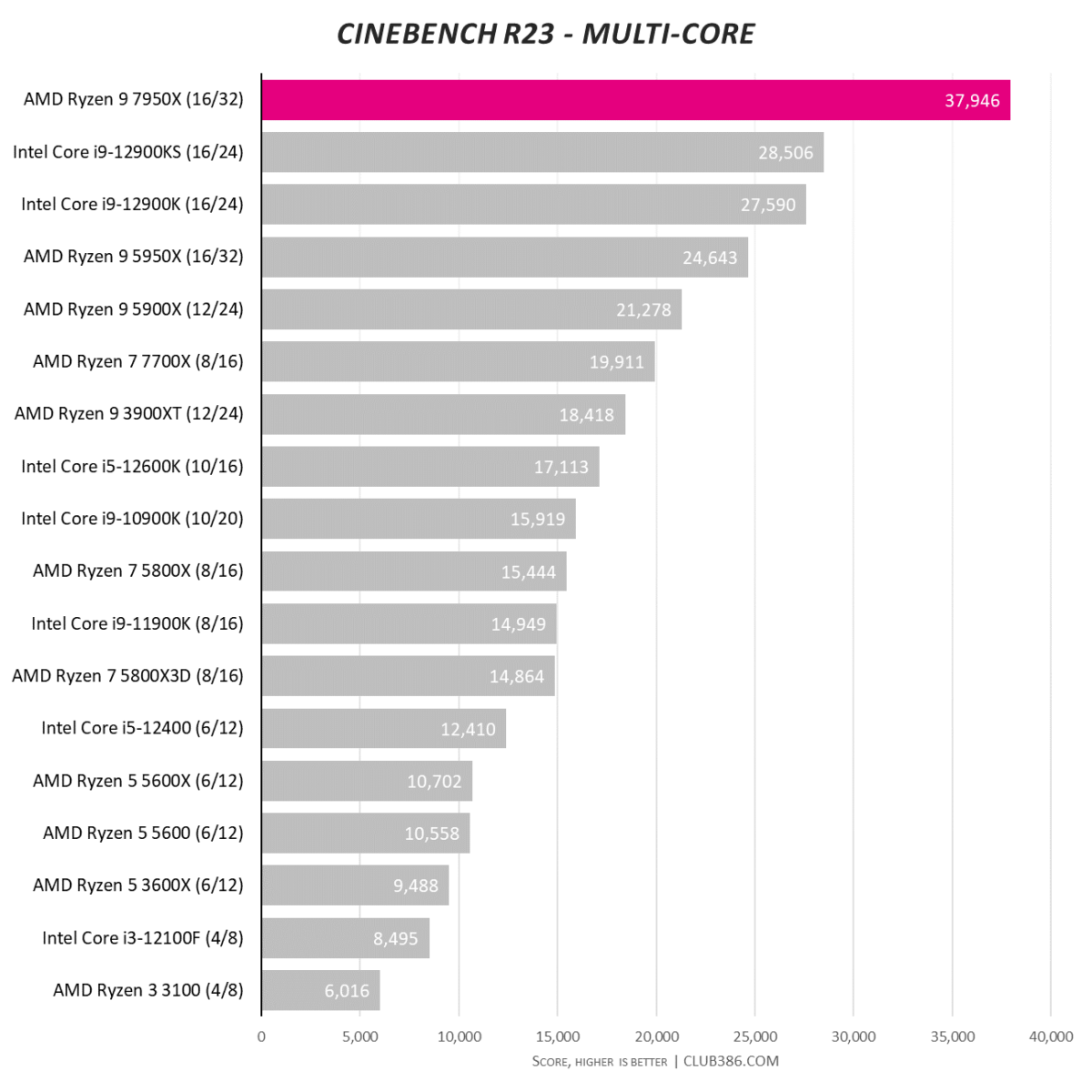
This is what happens when 32 Zen 4 threads hum along at a hair over 5.1GHz. Bish bash bosh, that’s what. Ryzen 9 7950X tombstones the previous champ, Core i9-12900KS, into next week.
Over 50 per cent faster than the previous best CPU, the Ryzen 9 5950X, and in a different league altogether, Ryzen 9 7950X can rightly be hailed as a true HEDT chip.
For reference, the score is reasonably close to the 43K achieved by an AMD Ryzen Threadripper Pro 3975WX, which is a chip designed for a completely different performance segment. Older Ryzen Threadripper CPUs, hold my beer.
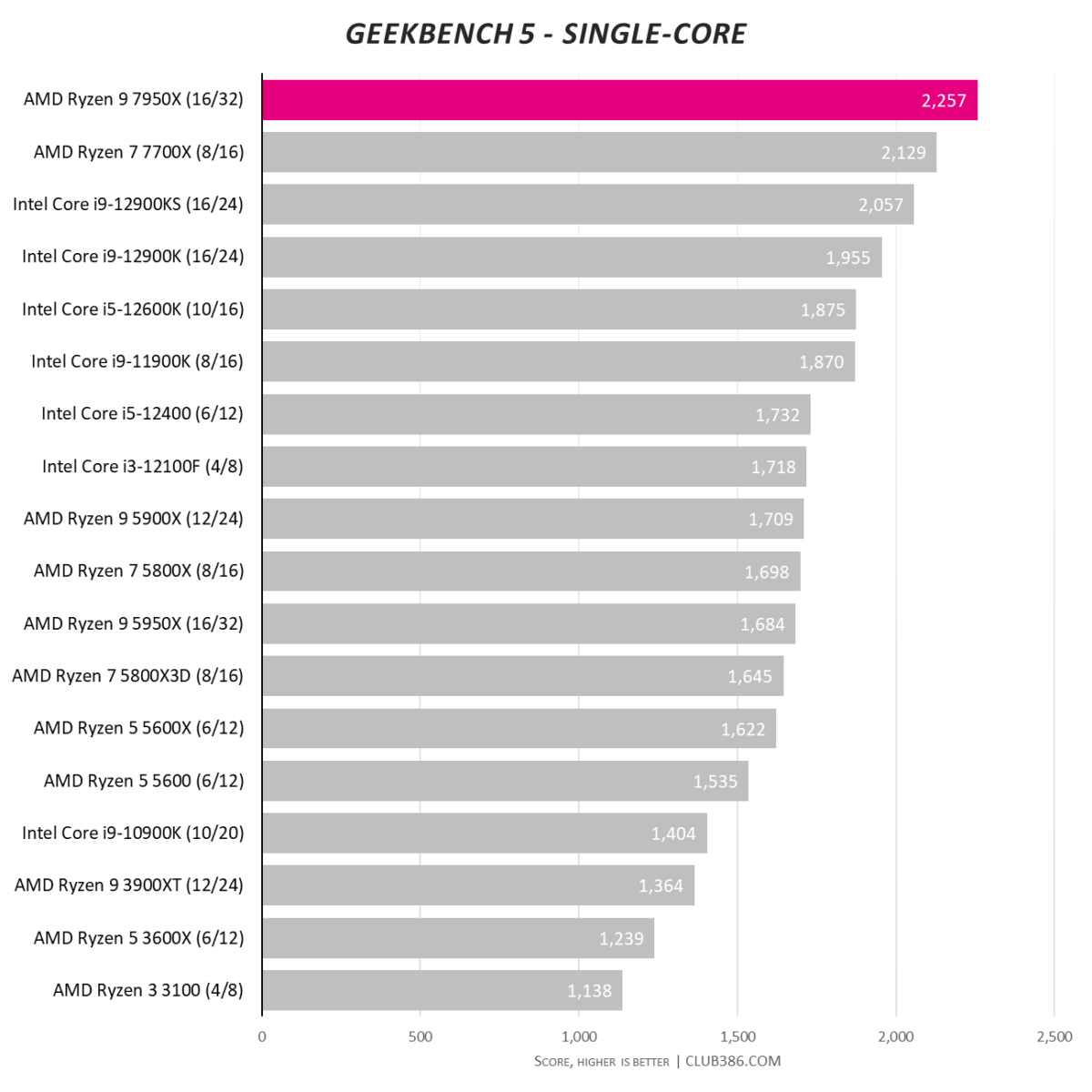
Reinforcing the numbers seen in Cinebench, cross-platform Geekbench 5 is loving Ryzen 9 7950X.
Ryzen 7 7700X is also cut from the same Zen 4 cloth. Read our in-depth review right over here.
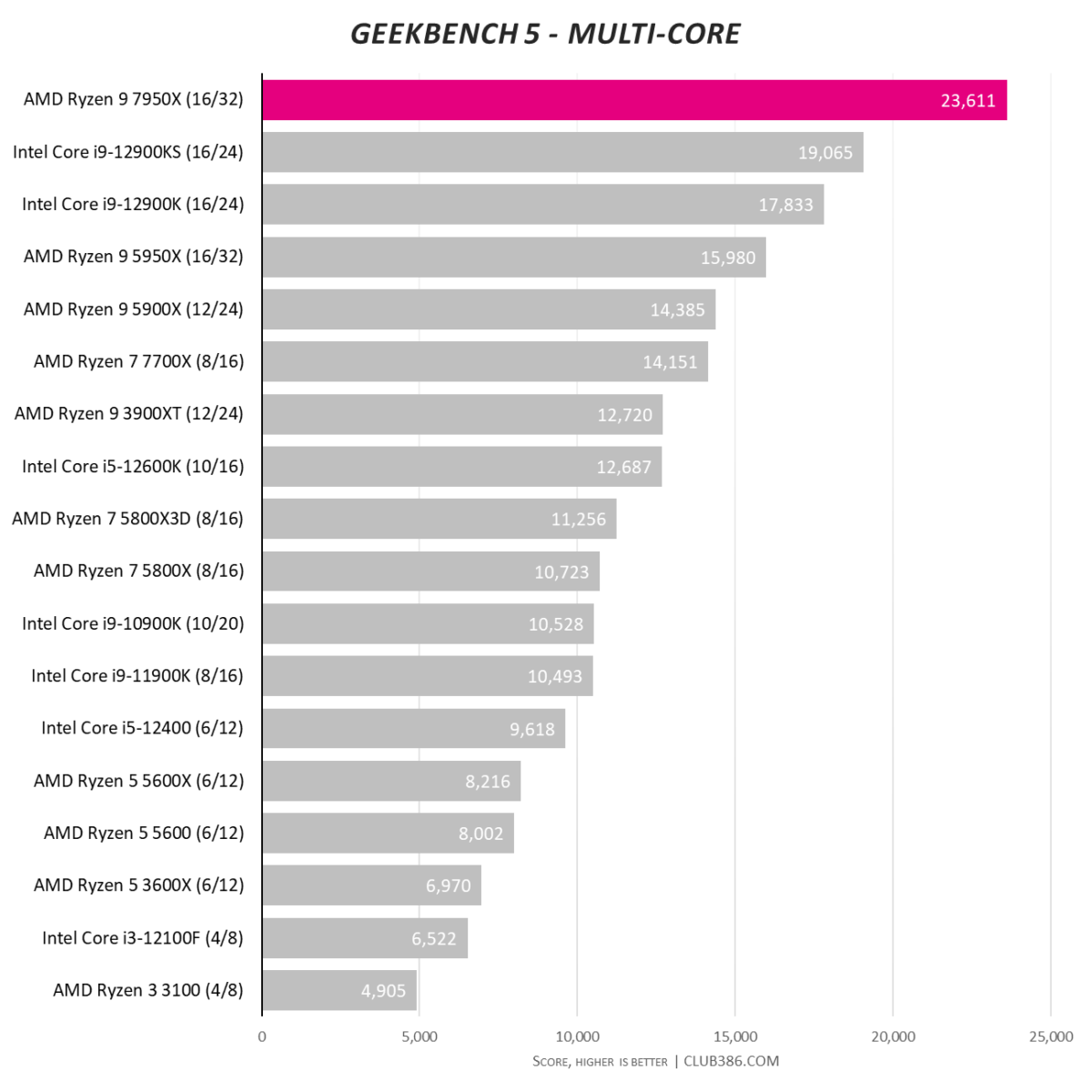
You know a chip is fast when you have to push out the x-axis from previous graphs. F&IPC (frequency and IPC) is king.
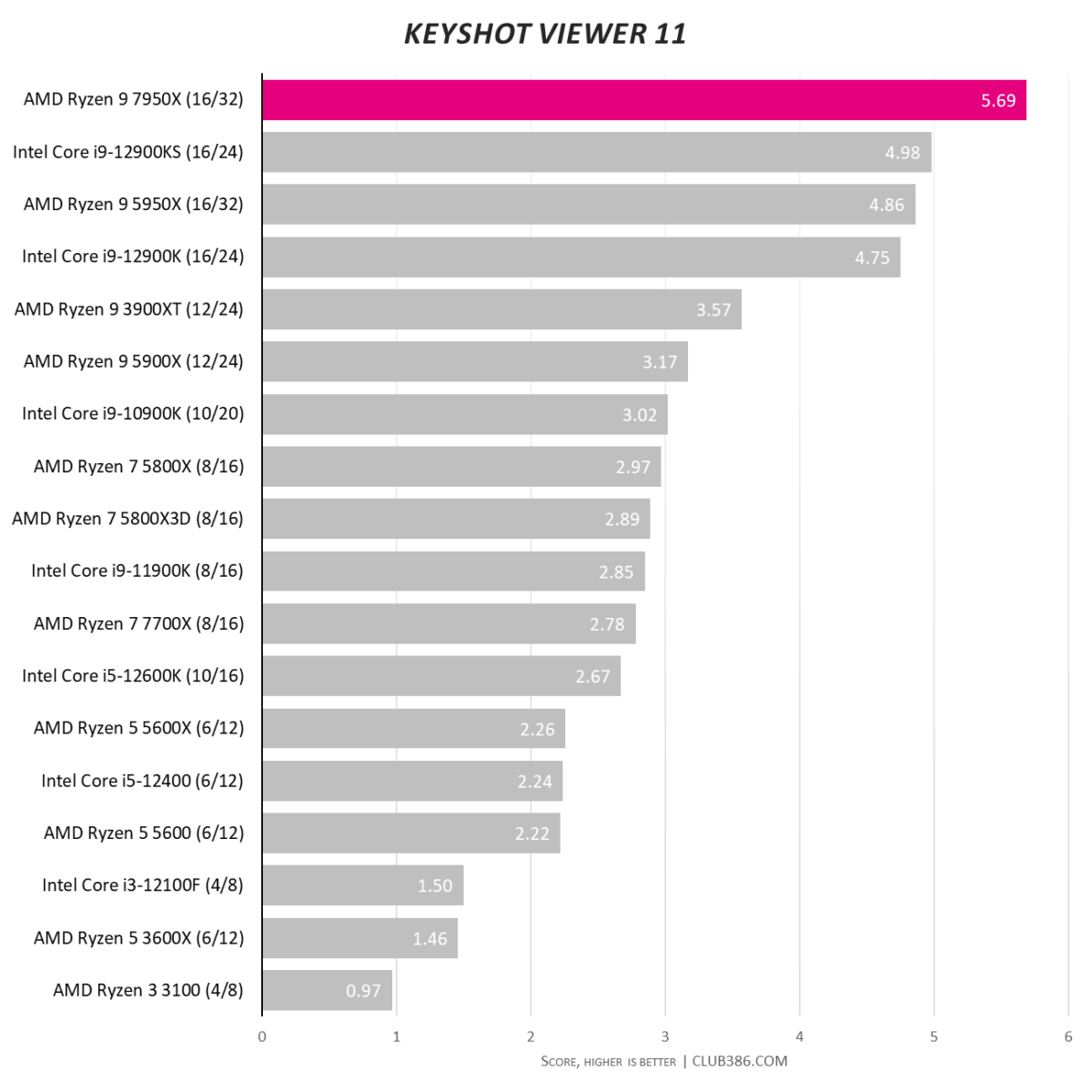
KeyShot is relevant as it’s used by many rendering professionals. If time is money, the $699 ticket fee begins to make sense.
Memory
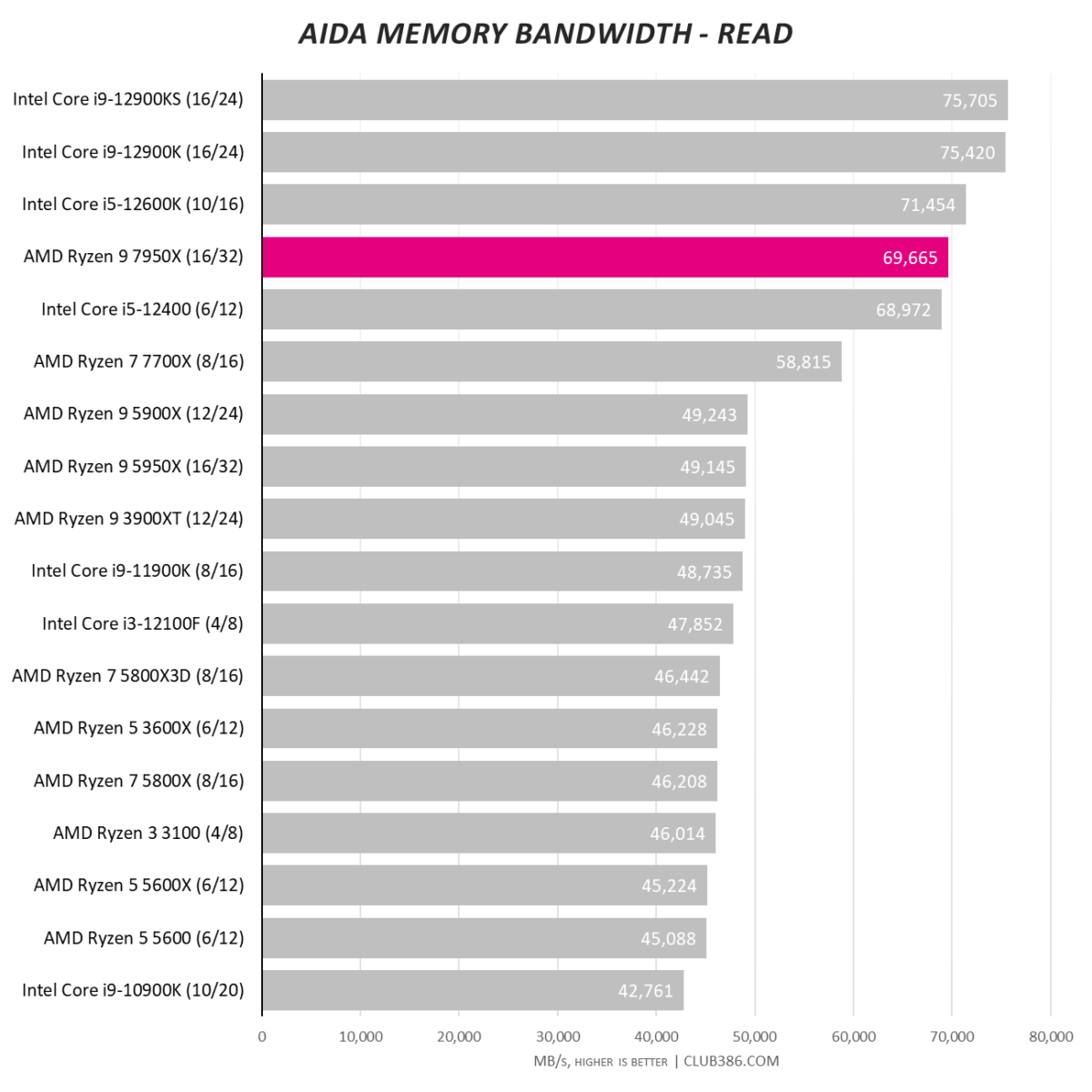
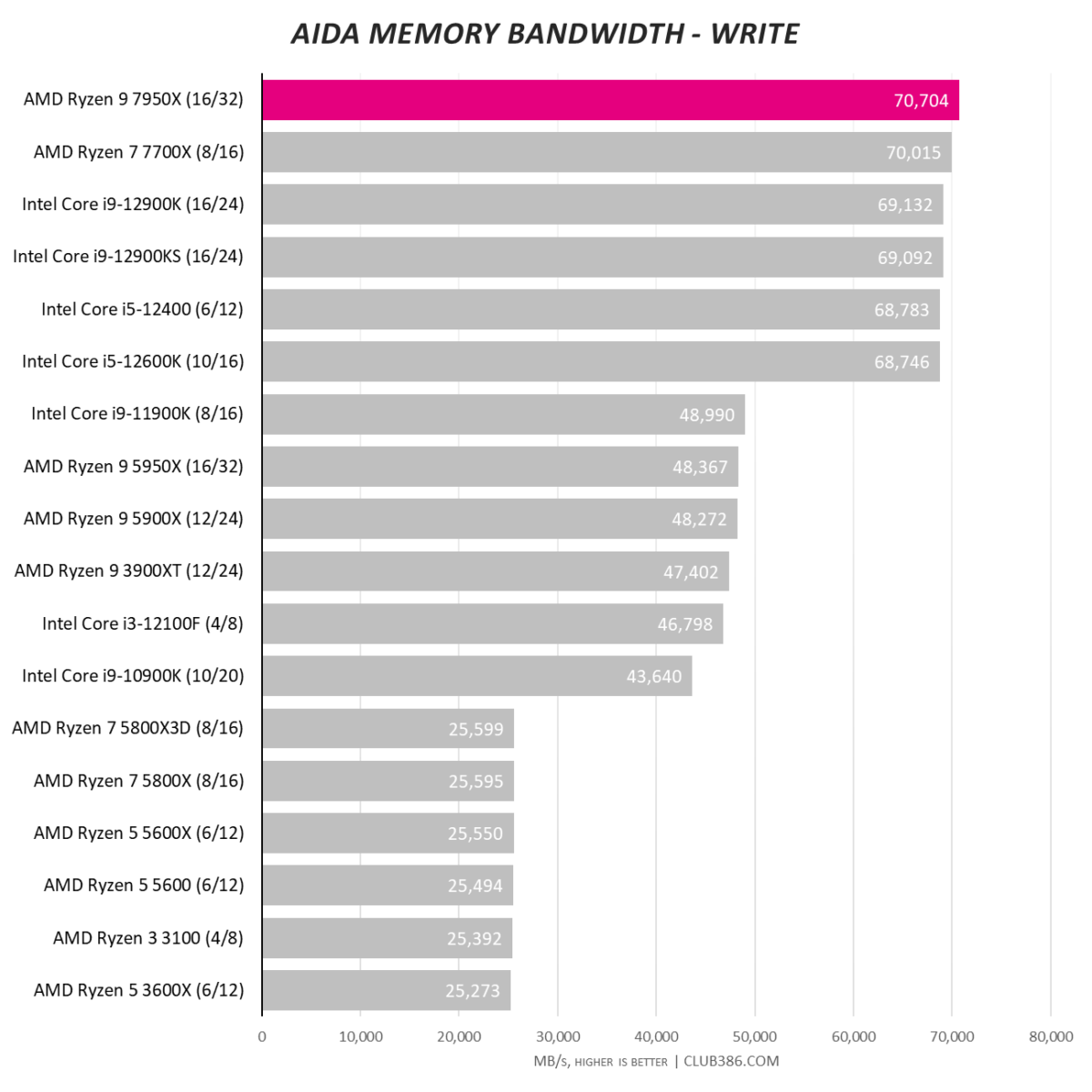
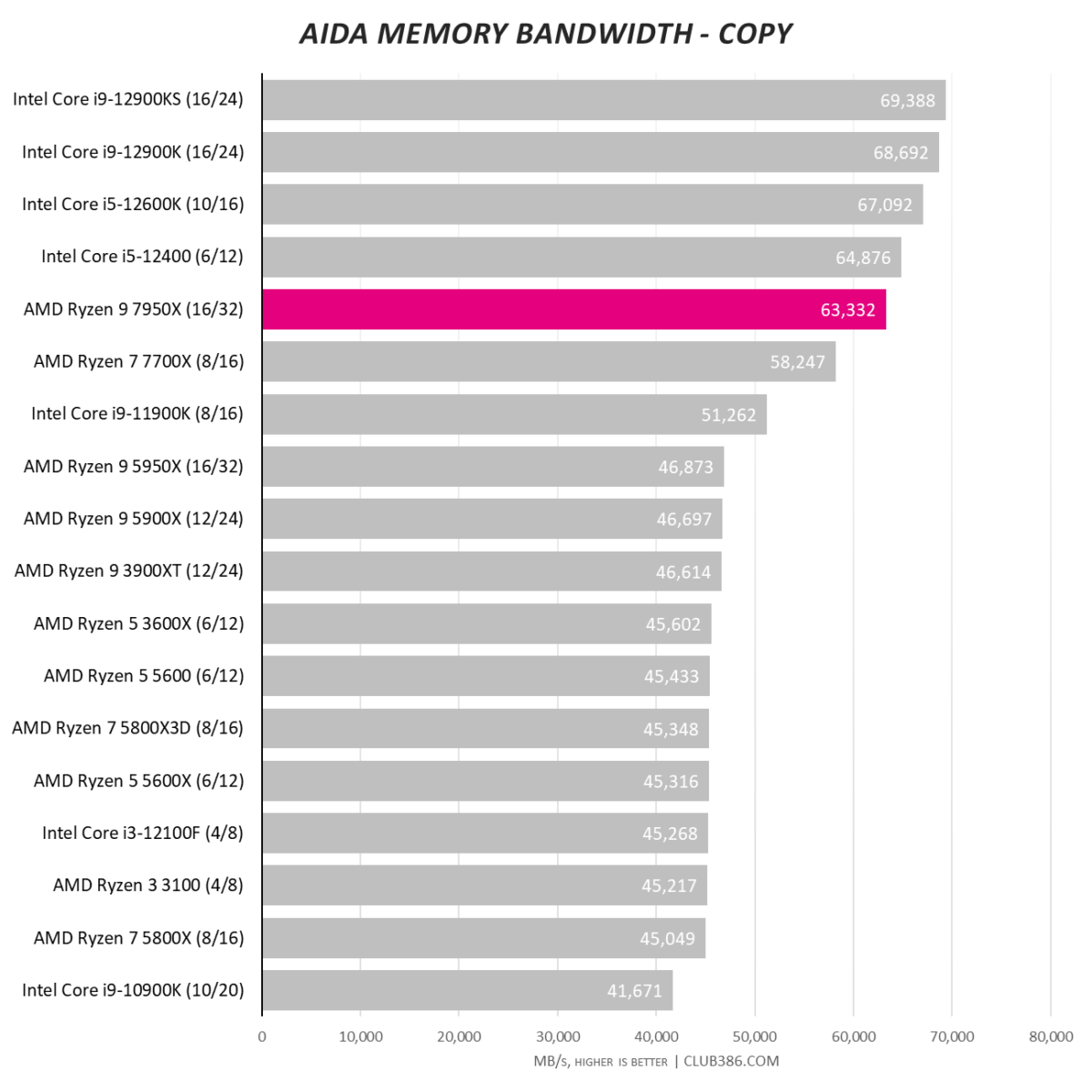
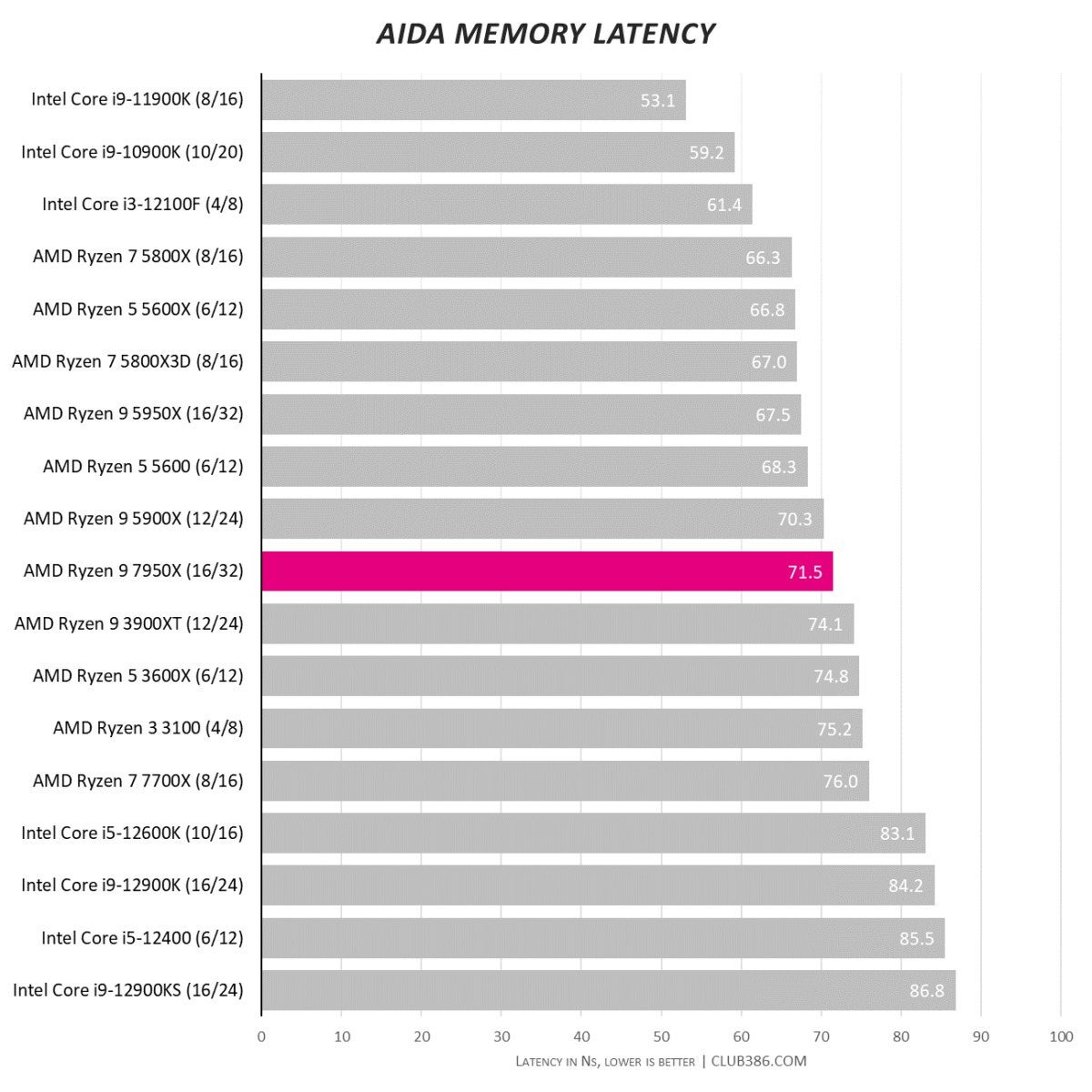
This is interesting. Ryzen 9 7950X is run at DDR5-5200 per specifications. Low-latency EXPO memory ought to offer oodles of bandwidth, but AMD struggles to best rival Core i9 chips run with the default DDR5-4800 speeds.
What Ryzen 9 gives up in bandwidth it more than makes up for in latency. Horses for courses and all that.
System and Gaming
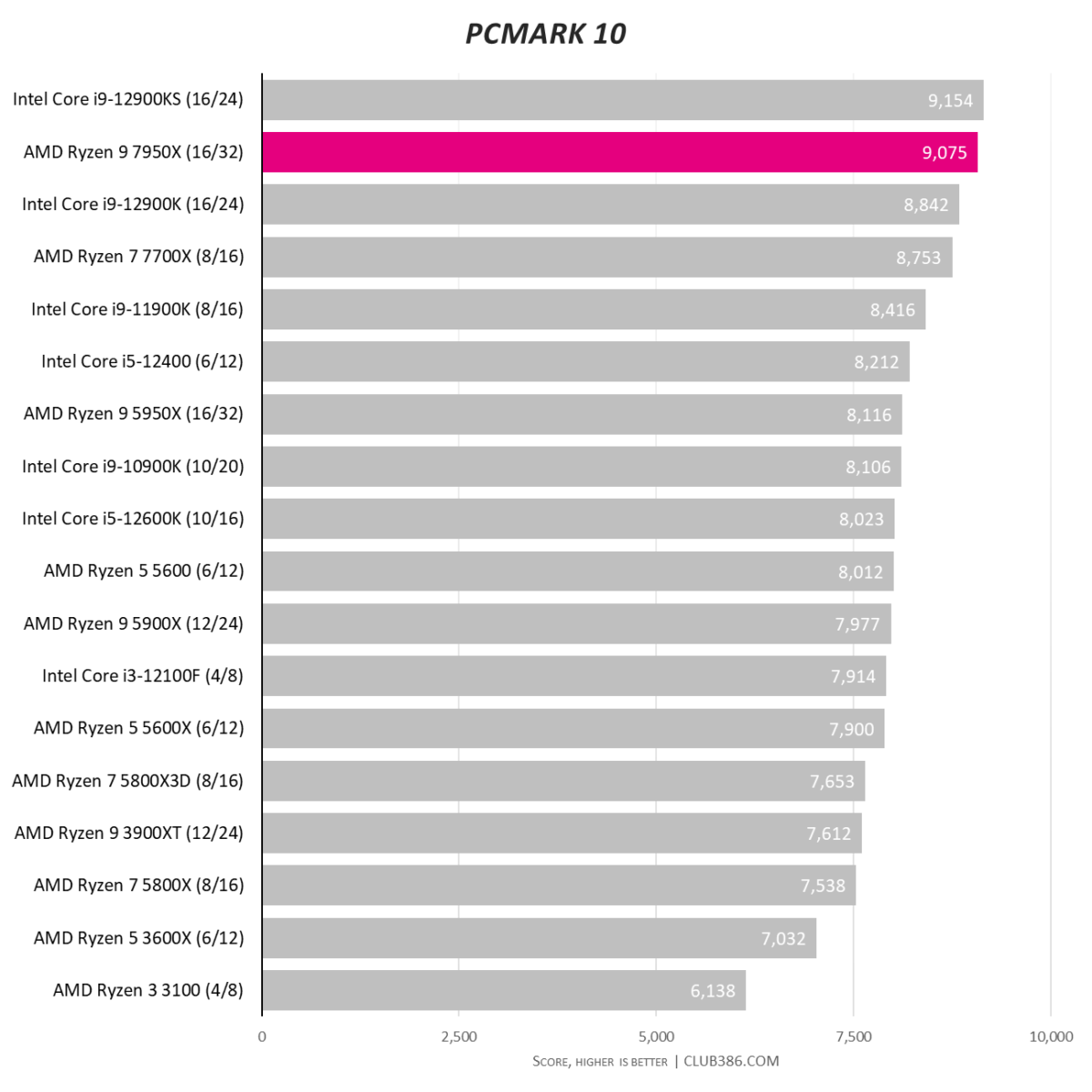
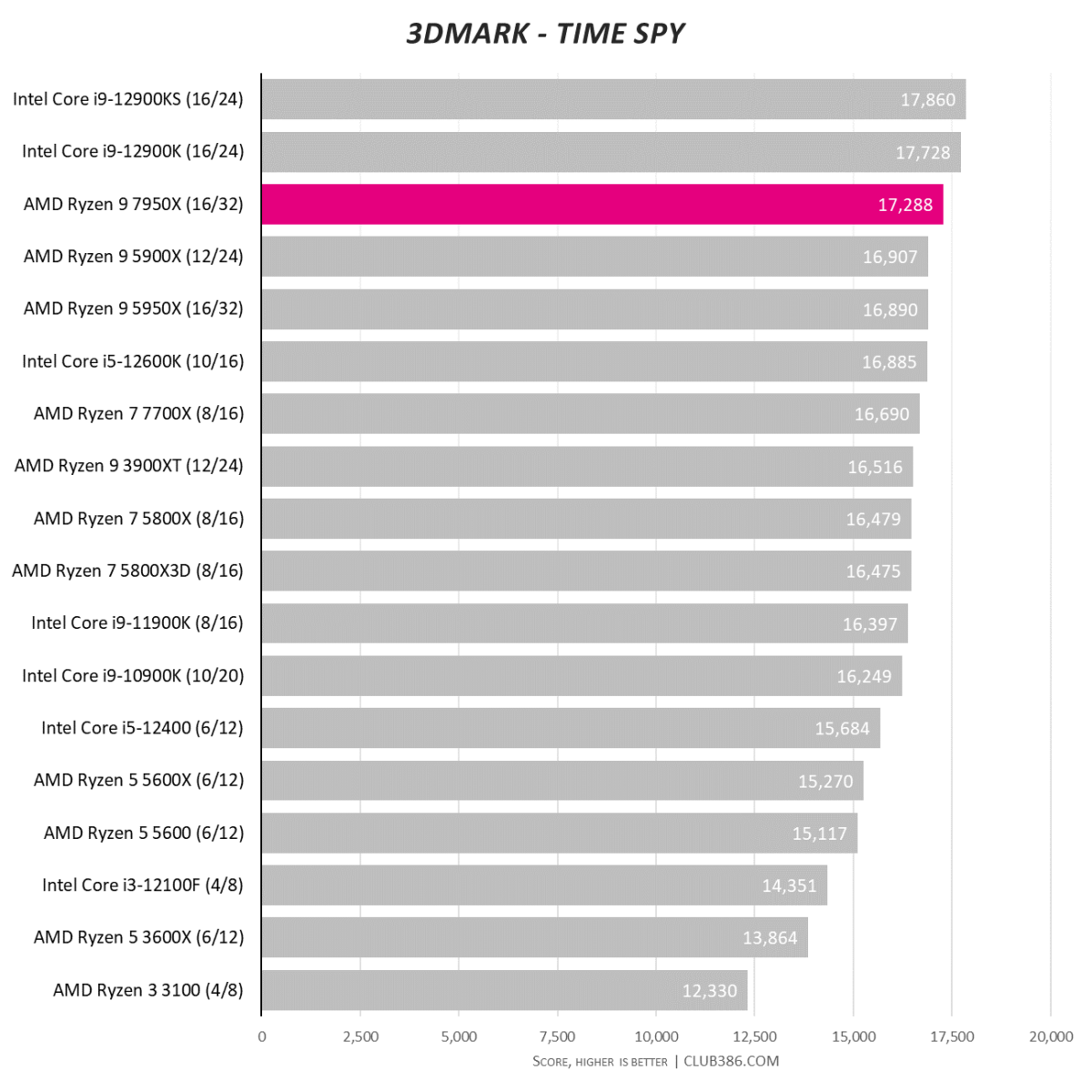
A solid showing, AMD isn’t going to win all the benchmarks.
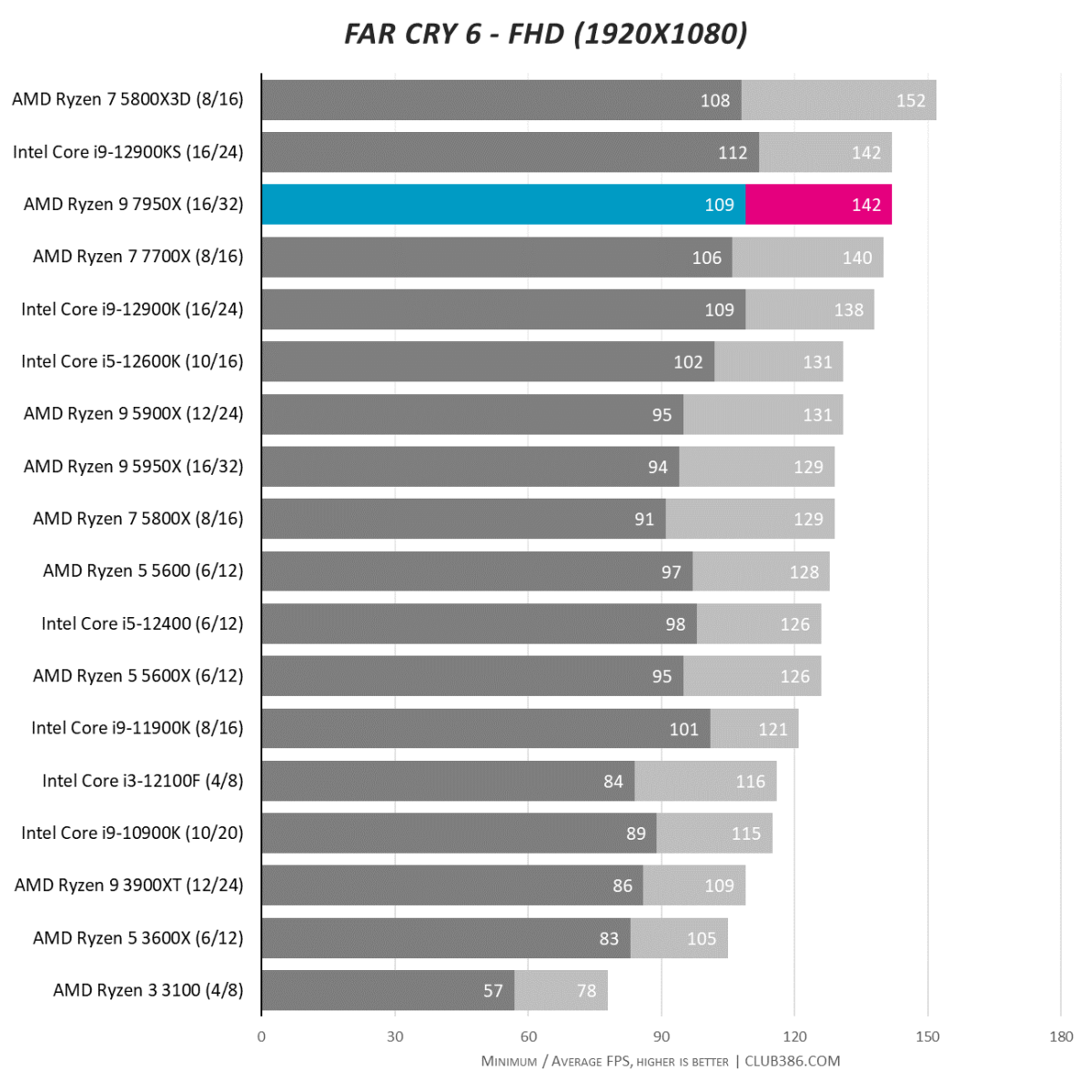
The first two games, testing with a GeForce RTX 3080 FE running best image-quality setting at 1080p, shows Zen 4 continuing the good work. Nevertheless, the cache-endowed Ryzen 7 5800X3D smokes Ryzen 9 7950X in Far Cry 6. Gamers seeking framerate nirvana are best advised to wait until the start of next year when all rumours point to X3D models for Ryzen 7000 Series.
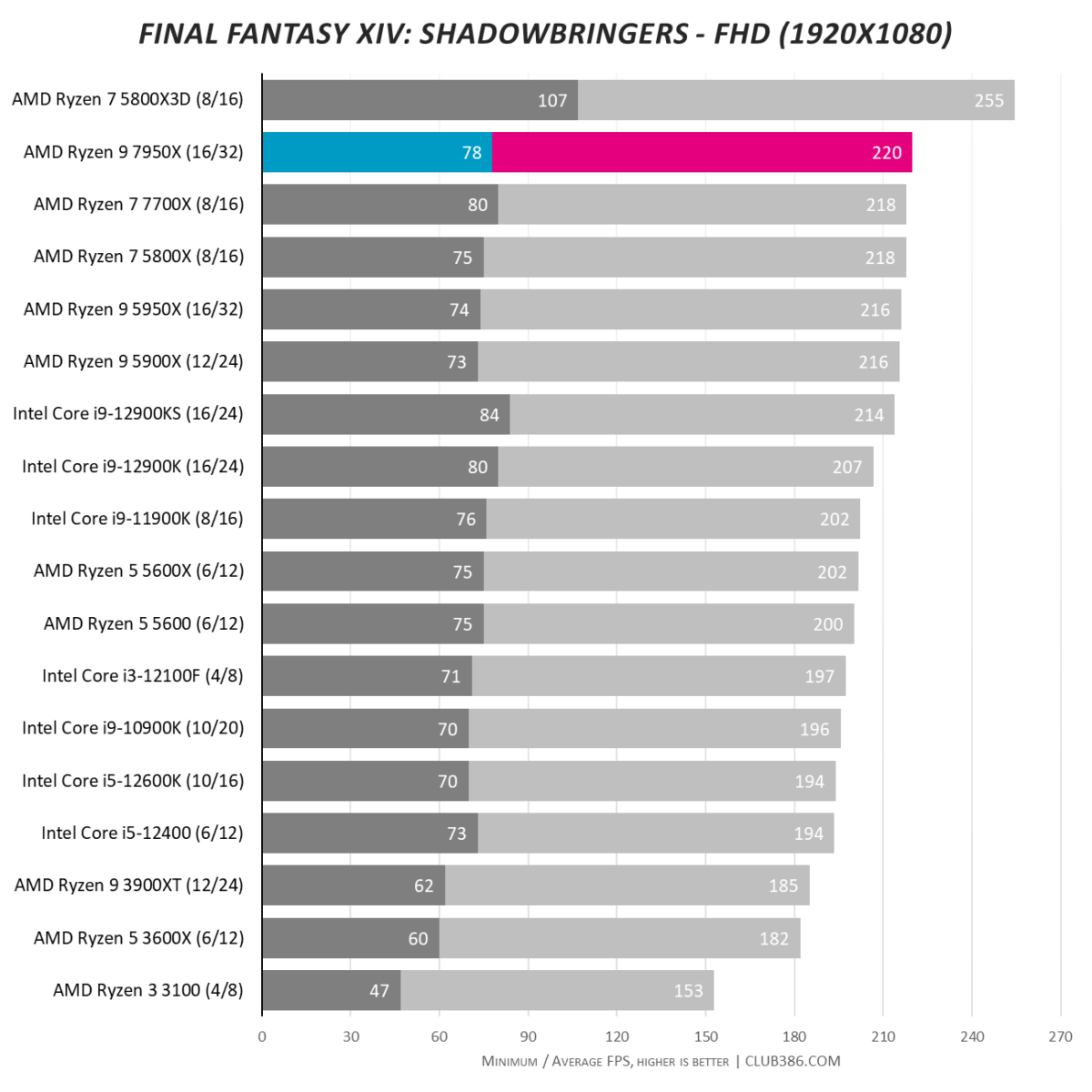
If Ryzen 9 7950X was smoked by Ryzen 7 5800X3D in Far Cry 6, it is positively set on fire in Final Fantasy XIV: Shadowbringers. Don’t mess with the cache king!
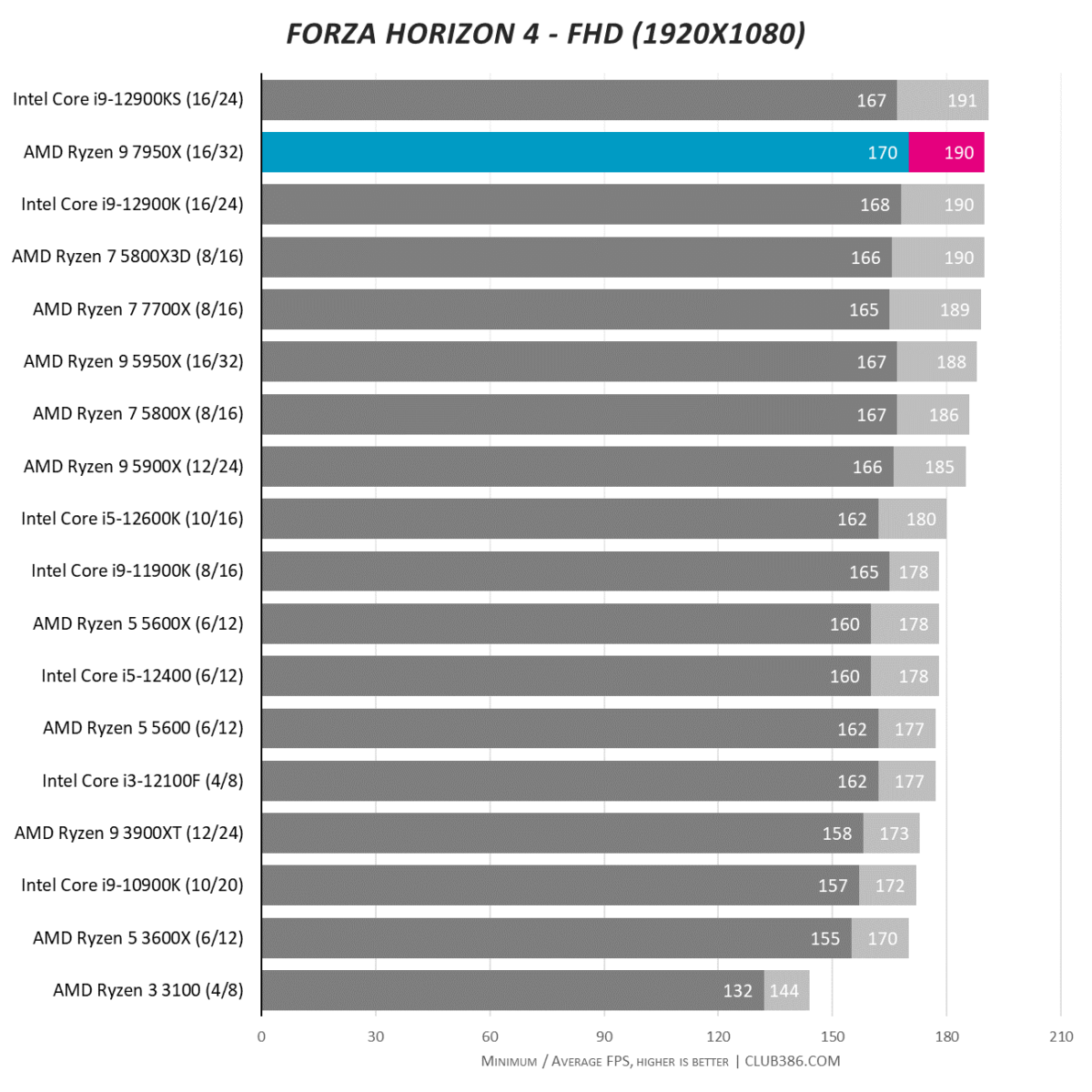
There remains little doubt Ryzen 9 7950X is a fine, fine chip for gaming.
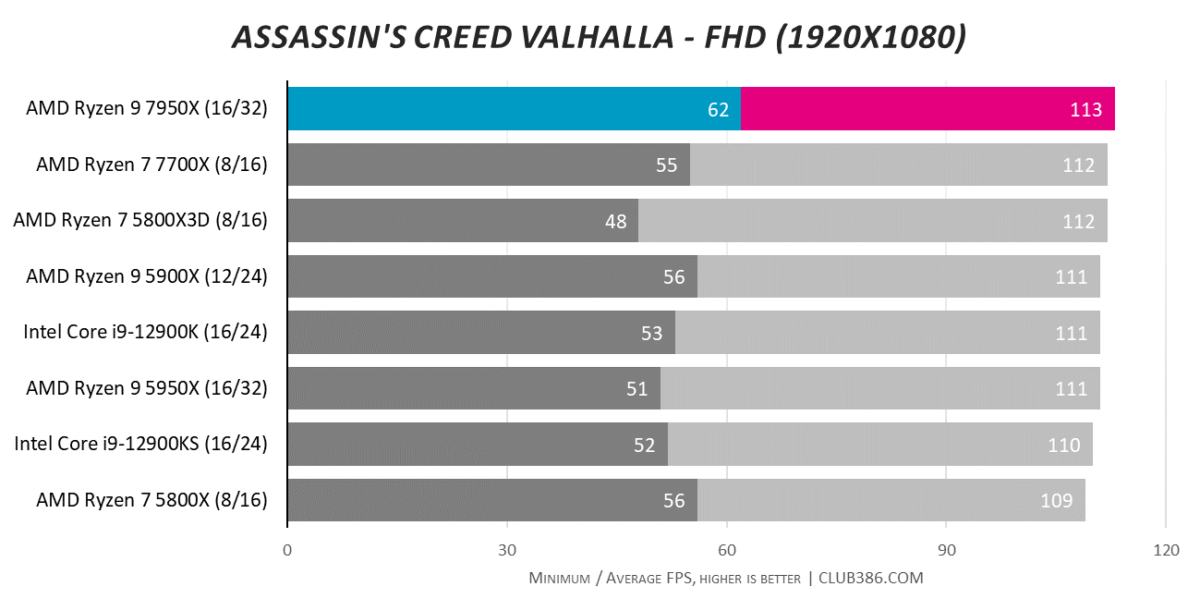
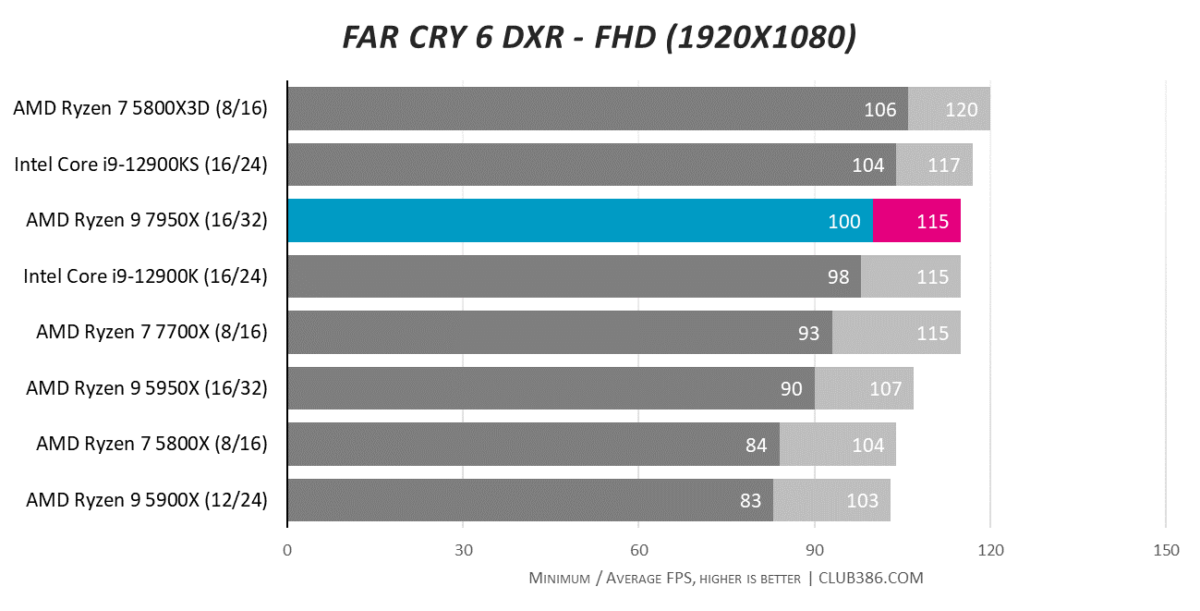
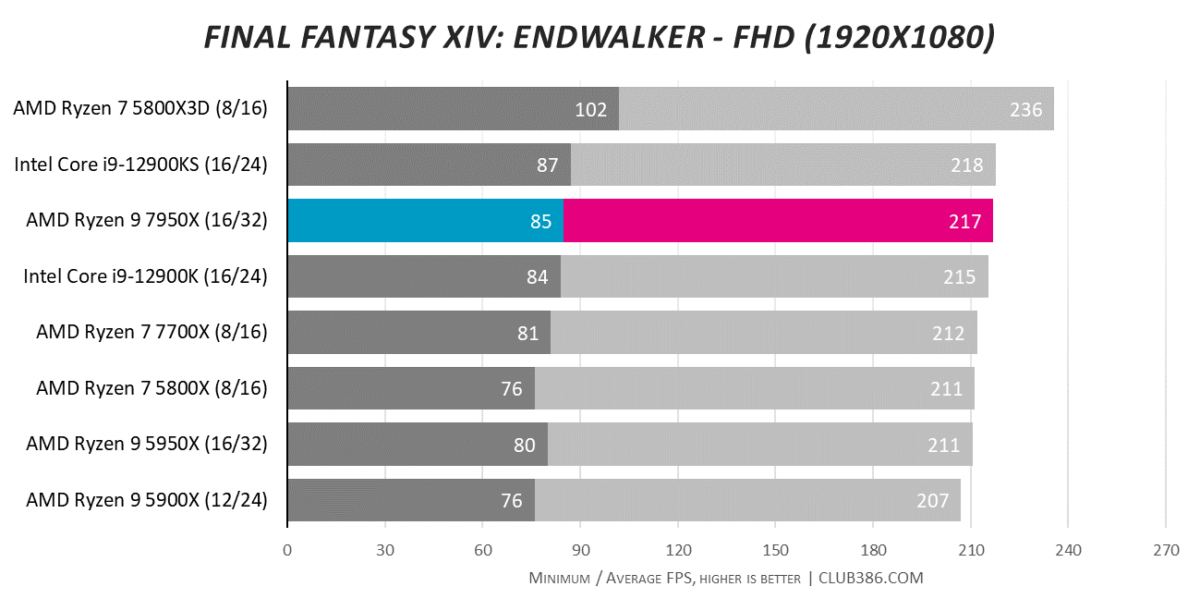
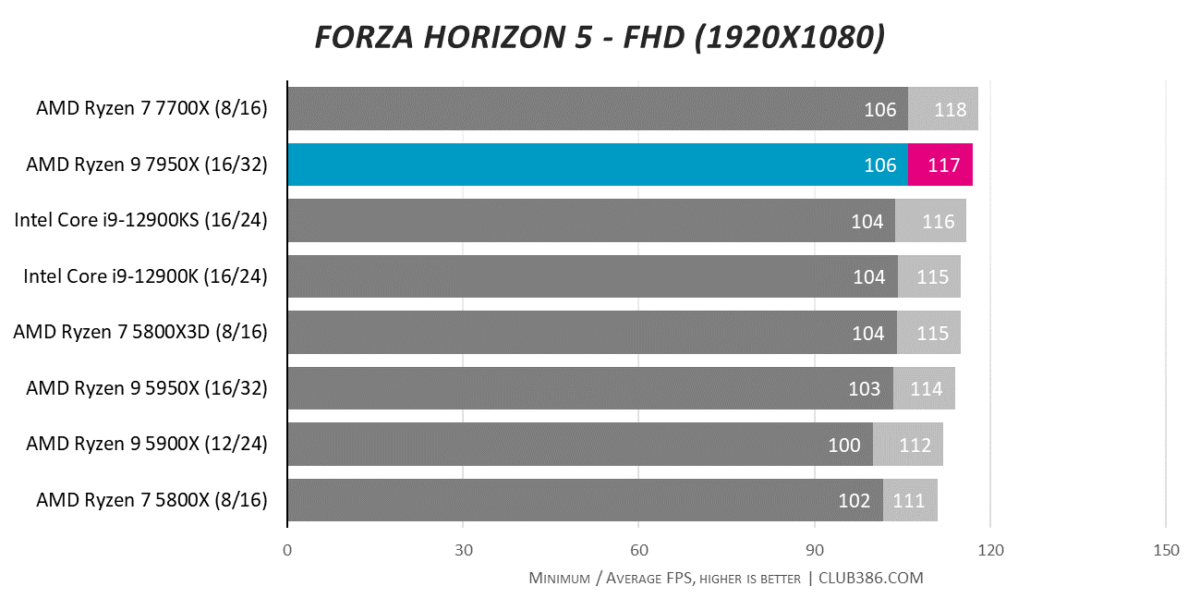
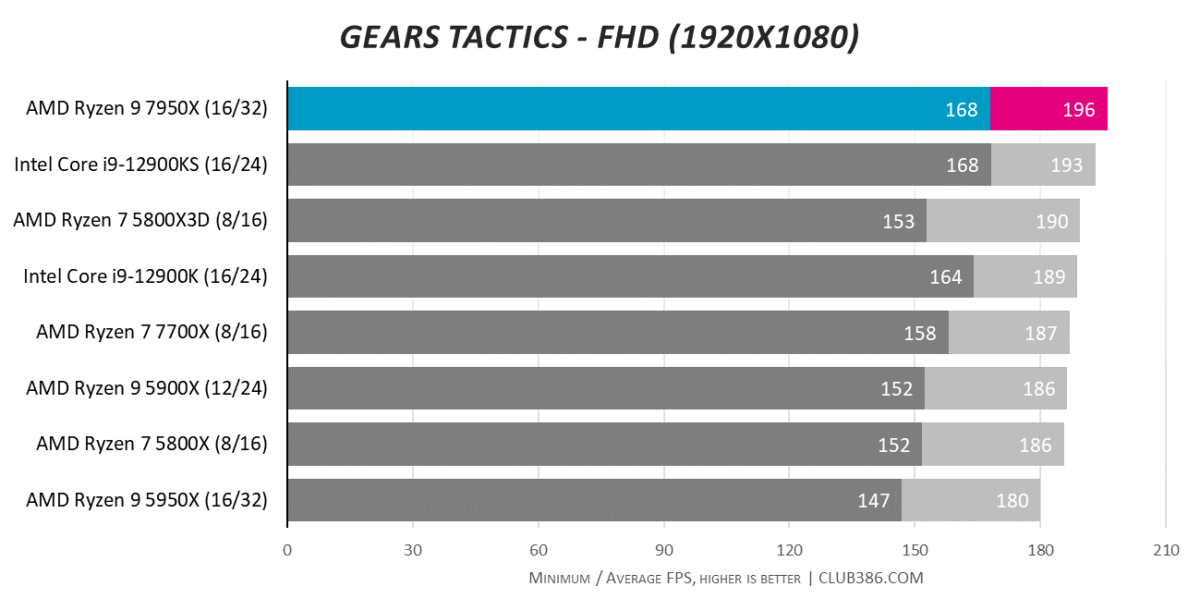
Five further games are run at 1080p high/ultra-quality settings to separate the wheat from the chaff. The review chip is some fine mid-west wheat.
That GPU and AVX-512
Two new additions for this series are a baked-in GPU and double-pumped AVX-512 support. Key advancements which bring the platform right up to date.
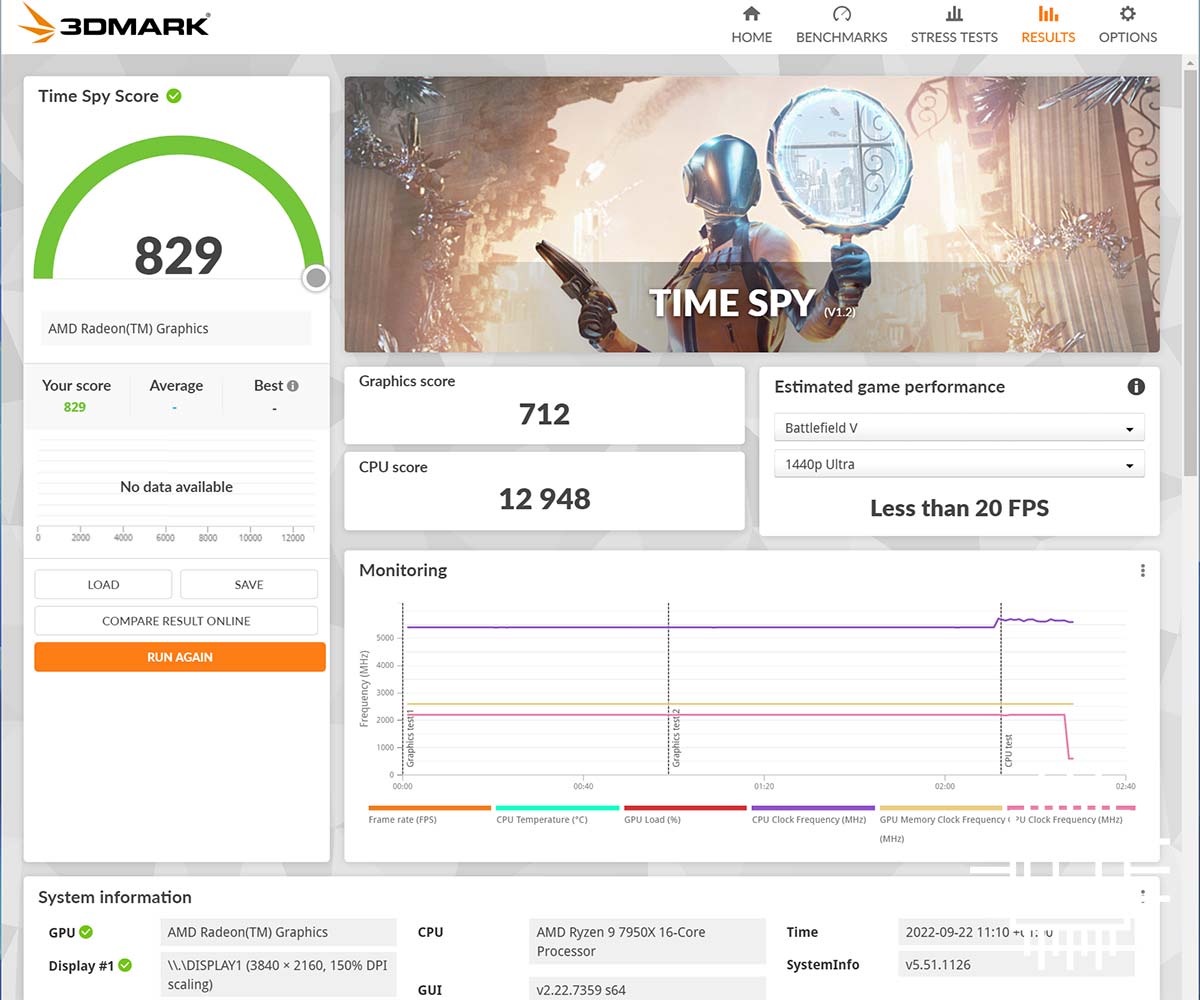
Focussing on GPU first, the 128 cores are from the latest RDNA 2 vintage are a mobile-inspired technology. Mendocino, looking at you. Getting a gist for performance, the system returns 829 marks in the default 3DMark Time Spy test, 2,129 marks in Fire Strike, and comparing like for like, 14.4FPS in the Final Fantasy: Shadowbringers test illustrated above with a GeForce RTX 3080 FE returning in excess of 200FPS.
We can confirm the GPU does encode H.265 and decode cutting-edge AV1, which is a major plus for budding content creators, and this function remains active even if a discrete card is added to the board. Another plus point is support for HDMI 2.1 and DisplayPort 2.0.
Switching gears out to AVX-512, Ryzen 9 7950X returns 10.2GB/s in the AIDA64 CPU SHA3 test, compared to just 6.1GB/s for Ryzen 9 5950X. Impressive, most impressive.
Power, Temperature, Efficiency, Value
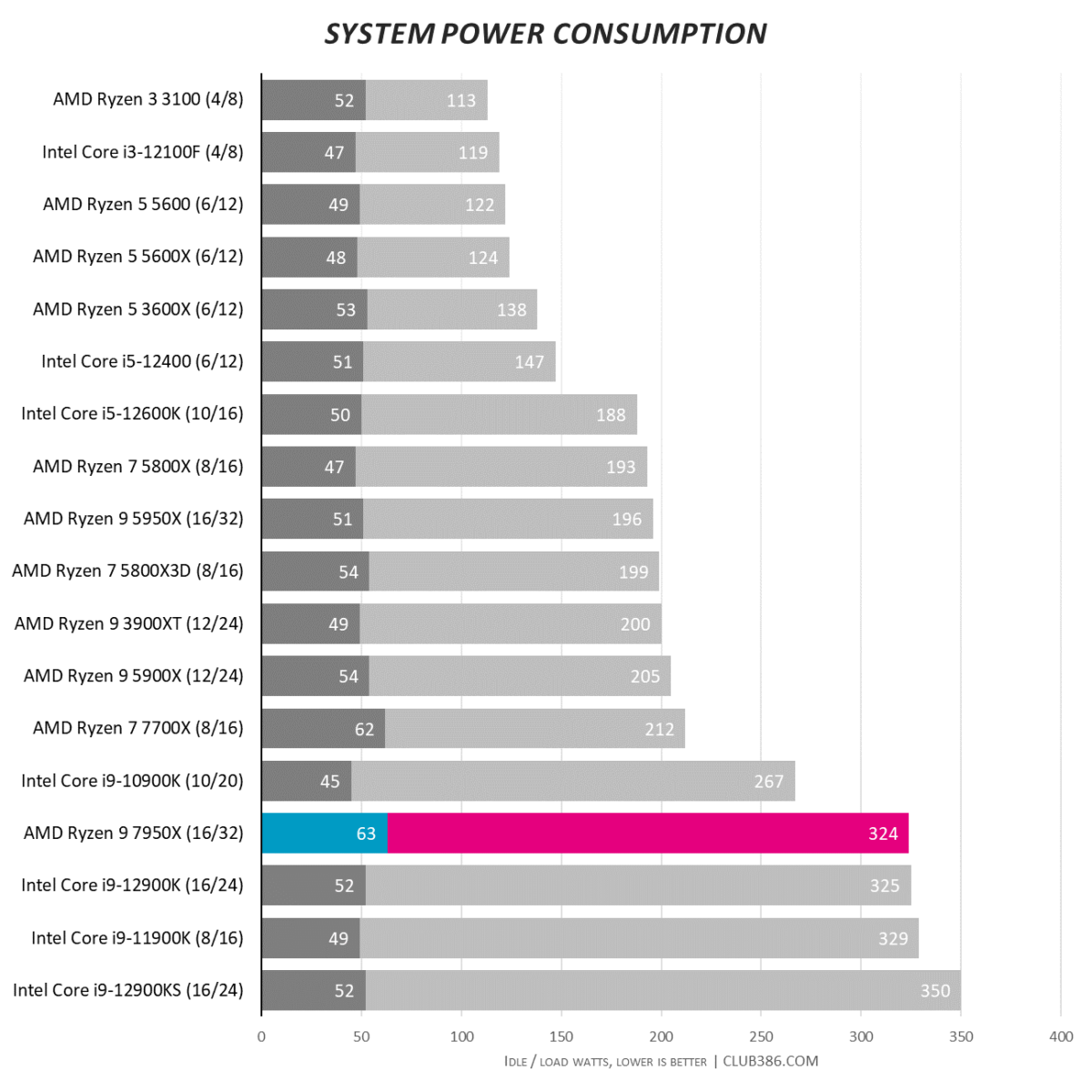
The first time Ryzen 9 7950X places well down the pecking order, but let’s face it, the positioning is not unexpected. Remember that the two premier Ryzen 7000 Series chips have a 170W TDP and 230W socket power, which is way above the 105W/142W, respectively, AMD has to stuck to on AM4. Well, AM5 fundamentally rents open the power envelope for that last drop of performance.
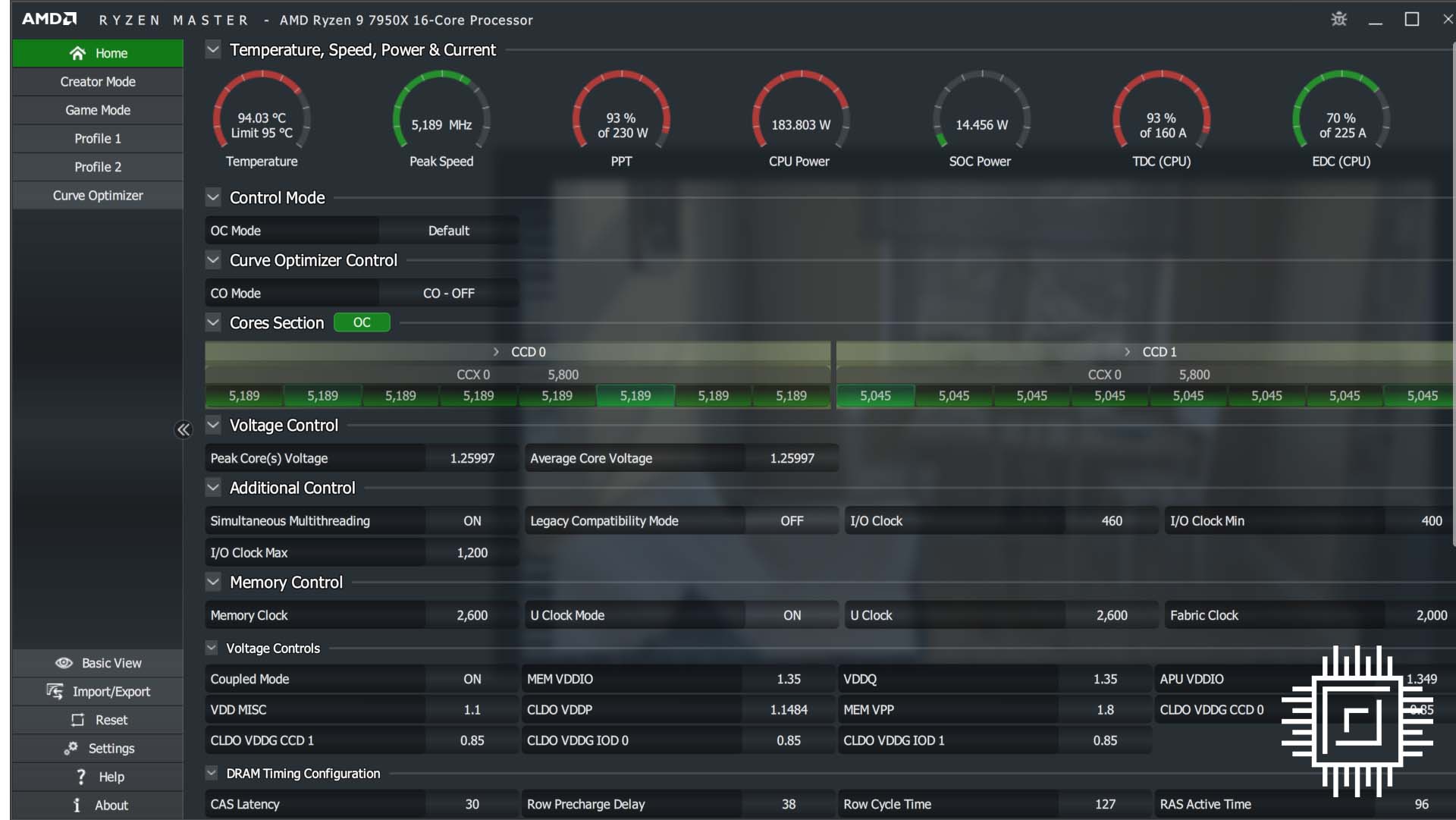
Here’s what’s actually happening when the processor is under full load. Run at completely default settings on an Asus ROG X670E Hero motherboard, the chip takes the opportunity of pulling most of the 230W PPT and races past its native 170W TDP rating. Pulling close to 200W alone, which is close to what Ryzen 9 5950X uses a a complete platform, AMD guns for absolute top-notch performance through copious amounts of power.
Reasons why AMD offers so much power, relative to previous generations, are twofold. The first is that the AM5 platform enables it to do so, meaning why not. The second is priming for the highest possible frequency is the simplest way for fending off upcoming Intel Core i9-13900K, equipped with more cores and threads than the present Alder Lake king.
Notice the high temperature even when under a Noctua NH-D15 chromax.black heatsink. Normally a cause for concern, AMD reckons this as a “safe operating temperature,” further adding that Ryzen 7000 processors are “designed to run at TJMax 24/7 without risk of damage or deterioration.” That’s okay for the seasoned enthusiasts versed in GPU temperatures, but may cause consternation for novice users who consider near-100°C way too hot for comfort.
Not only that. Most motherboard BIOSes are designed to increase fan speed markedly as CPU temperature escalates, meaning a quiet computing experience is only availed once you fine-tune the firmware to accept heaps of CPU-produced heat. Far from ideal.
The situation isn’t as pronounced when gaming, where only a few cores are tasked to provide the necessary geometry to the GPU. In that case, CPU temperature hovered between 75-80°C.
Creating a -100mV CPU voltage offset is enough to mostly preserve multi-core performance whilst reducing temperature to 81°C and maintaining stability. It feels like AMD has over specified the voltage part of the V/F curve, playing it very safe at the expense of temperature.
Ryzen 7000 Series does rather well when the power budget is trimmed back. Club386 has an entire feature dedicated to it. For example, run at the same 105W/142W native settings as Ryzen 9 5950X, today’s champion processor still returns over 35K in Cinebench R23 nT.
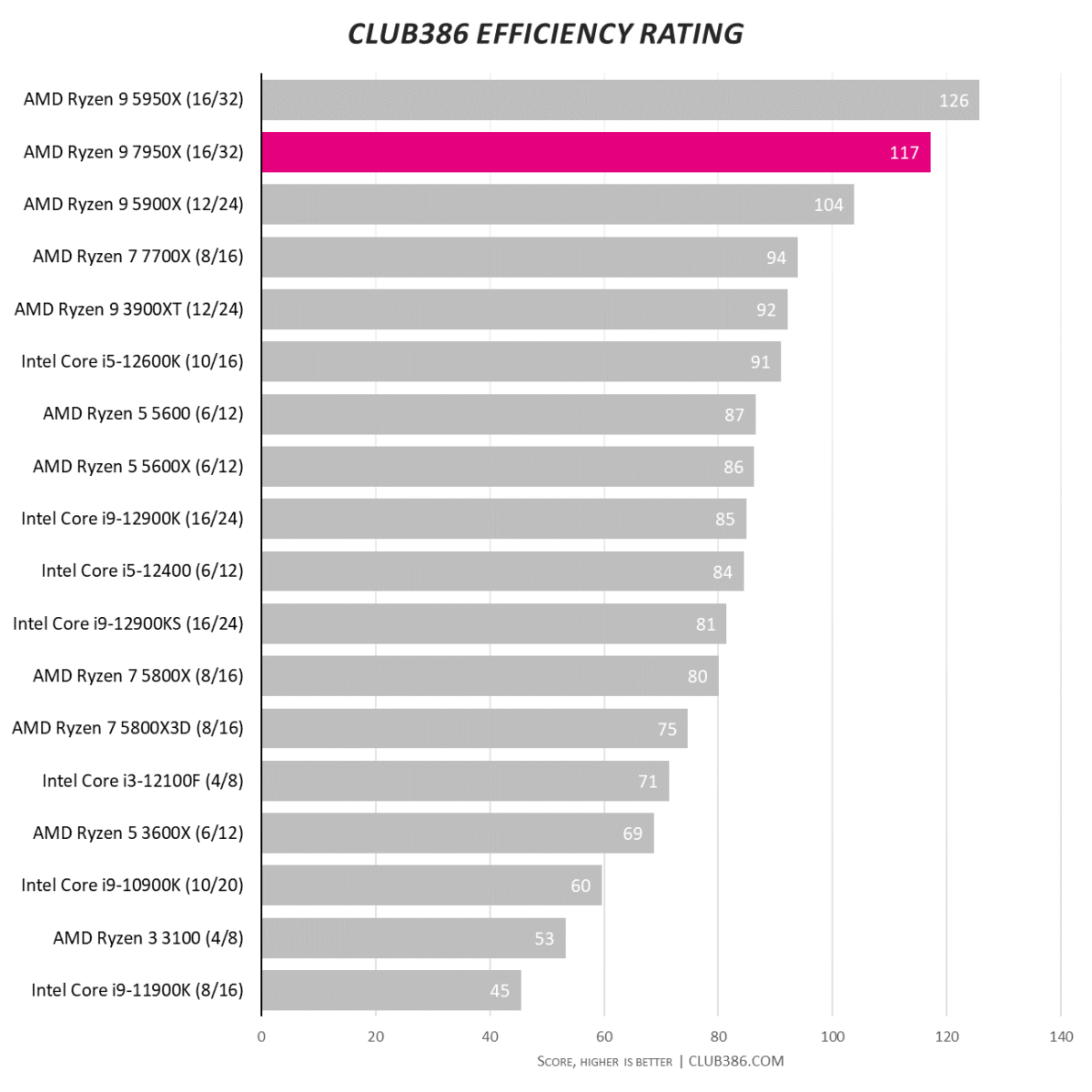
Hitting close to 40K in Cinebench bodes well for efficiency. Taking the gloss off it a touch is the high overall system power consumption. Nevertheless, dividing the score by the observed wattage provides the above graph.
A healthy return indeed, particularly when one considers AMD Ryzen 9 7950X’s frequency/voltage curve sits on the bleeding edge.
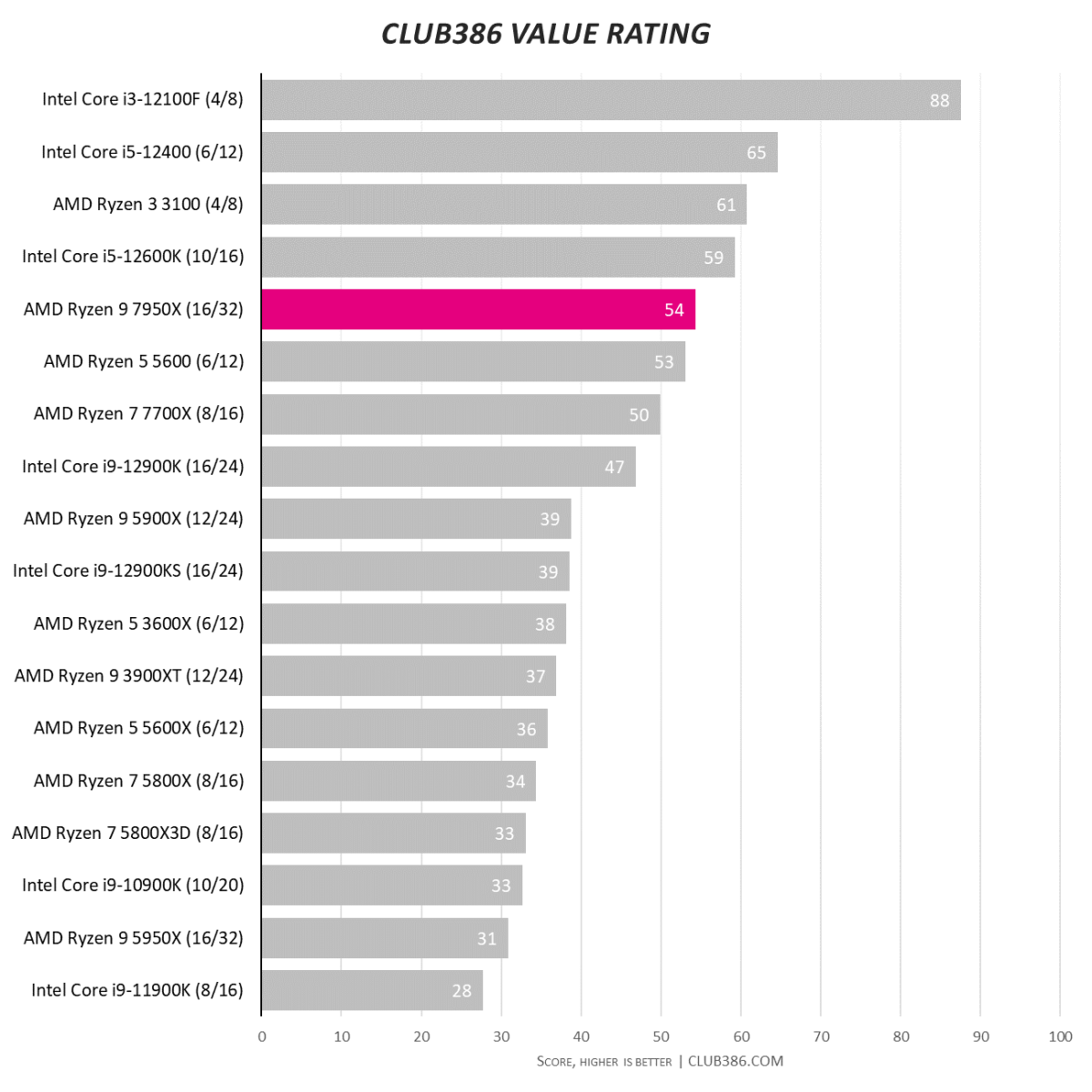
The value rating is derived by dividing the same Cinebench R23 nT score by the launch price so as to remove week-on-week fluctuations.
It’s generally hard for a top-tier chip to do well as they typically sell for solid premiums over mid-range processors. Nevertheless, the asking fee for Ryzen 9 7950X is restrained given the horsepower on show. Going by our calculations, it provides 74 per cent more relative value than Ryzen 9 5950X, which launched at $799! This is exactly why close competition is a good thing for our industry.
Conclusion
AMD unleashes Zen 4 on the desktop in impressive fashion with range-topping Ryzen 9 7950X. Offering the same 16 cores and 32 threads as the previous two generations, similarities swiftly end there. Equipped with a more performant architecture offering double-digit IPC improvements, the real star is hard-to-ignore boost in sheer frequency.
Historically playing a distant second fiddle to Intel Core in pure speed, the latest champion Ryzen creeps close to 6GHz on a single thread and north of 5GHz when all are called into action. That’s a 25 per cent improvement over Ryzen 9 5950X right there.
Ryzen 7000 Series also heralds a new AM5 platform making the most out of nascent technologies such as DDR5 and PCIe 5. Room has been made at the IOD inn for baked-in graphics from the latest RDNA 2 generation, albeit kept small enough to warrant use for outputs and encoding more so than proper gaming. Nevertheless, it’s a feature that’s long overdue and appreciated.
Yet it’s not all roses. AMD’s very own cache-enriched Ryzen 7 5800X3D is still arguably better for gaming and the parlous nature of the pound inflates UK pricing to £740, which is over 30 per cent more than previous head honcho Ryzen 9 5950X goes for right now. Being fair, the launch $699 dollar cost is actually lower than the $799 initially charged for the best overall chip of the last generation. Exchange rates and deep discounts, huh.
Then there’s the elevated TDP this generation which necessitates top-notch cooling to get the most out of it. The chip also runs hot, creeping up to 95°C, and we believe a better strategy would have been to install the long-trusted 105W TDP with the option of a 170W ‘Ryzen Roar’ mode in firmware.
Nevertheless, setting a new performance bar for mainstream PC chips, AMD has invigorated the premium space with high-frequency Zen 4-based Ryzen 7000 Series CPUs. Living within a larger power budget, Ryzen 9 7950X stretches considerable muscle to become the best mainstream PC processor. Over to you, Intel.
Verdict: Fantastic for content creators and solid for gaming, AMD Ryzen 9 7950X is hard to beat.


